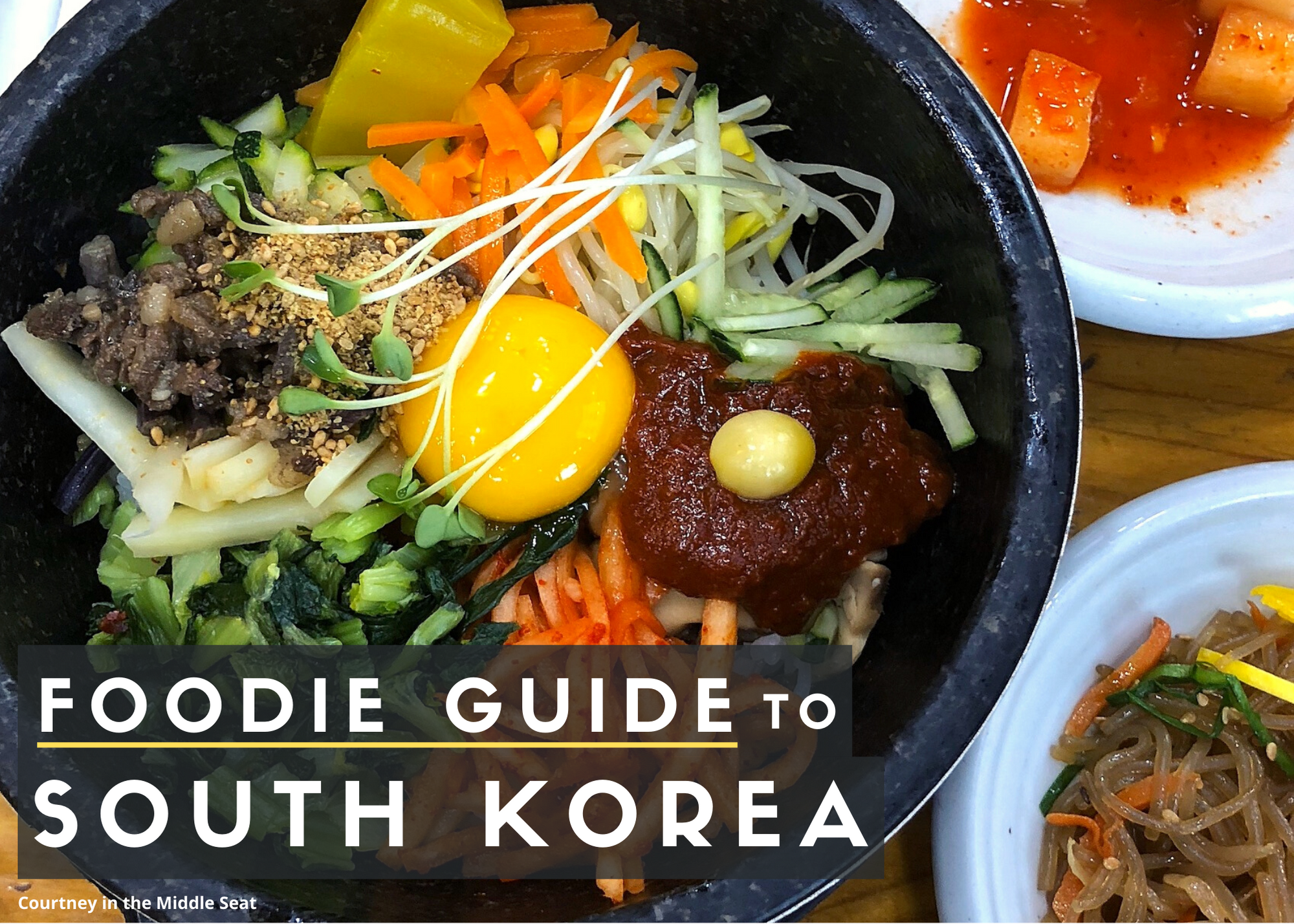
Foodie Guide to 2 Weeks in South Korea
I traveled to South Korea to eat. And each bite was better than the last! From locally grilled seafood to the tastiest street food options across the country, here are the meals and snacks that you want to try!
Most Delicious Meals & Snacks in South Korea
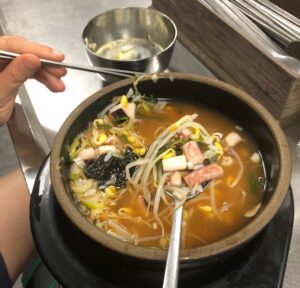
Bean Sprout & Rice Soup with Squid at Nambu Market
Table of Contents
South Korea is one of the most delicious places to enjoy a vacation (or even your honeymoon)! After our wedding, my wife & I spent 2 weeks eating our way around the country. South Korea is easy and affordable to navigate via public transit. In a 2 week trip you can visit multiple destinations without feeling rushed. Here is a round-up of the best foods we ate in South Korea.
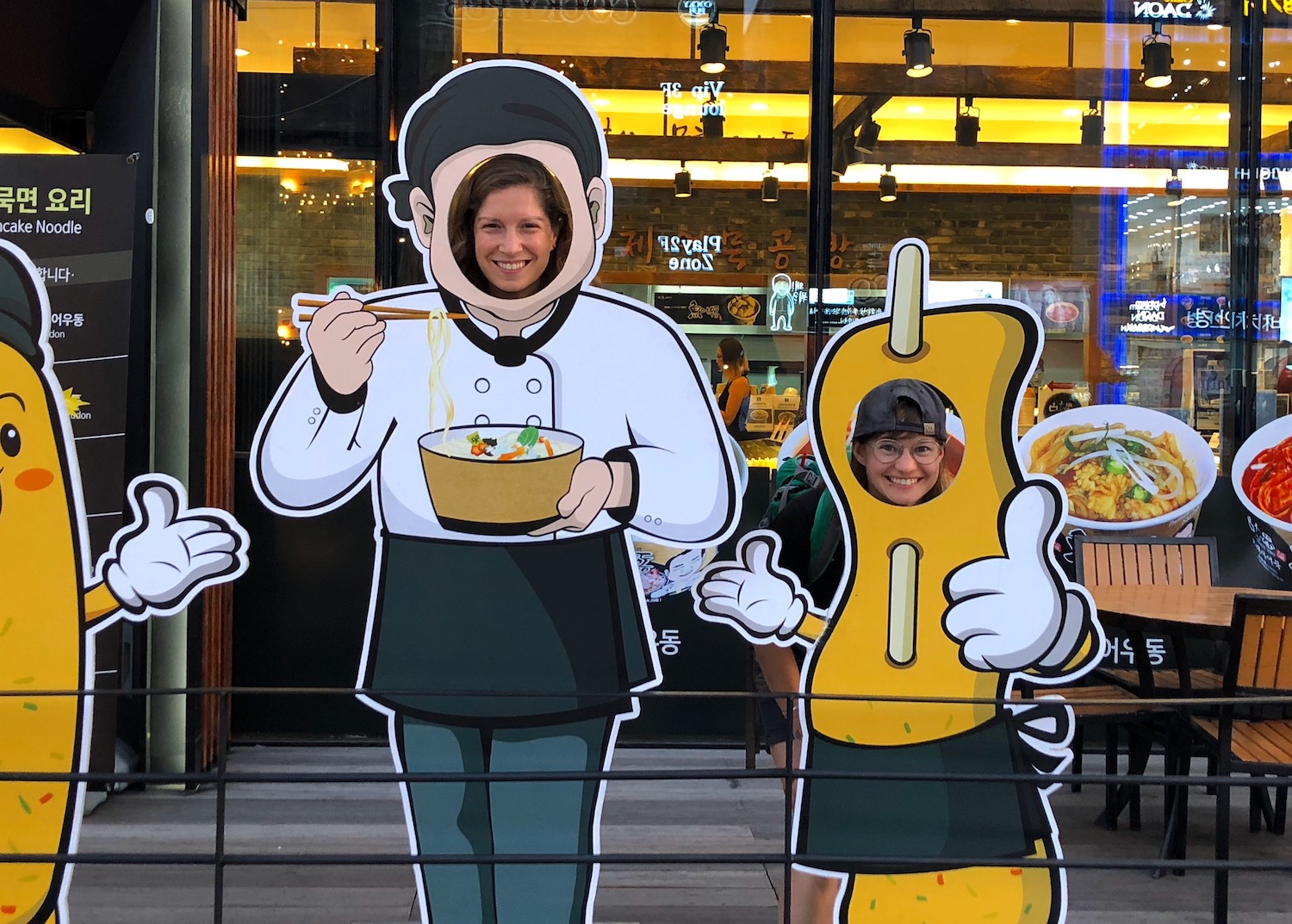
Flavors of Busan
Located on the southeastern tip of South Korea, Busan is the second most populous city with over 3 million people. Busan is a port city and economic hub well known for beaches, and of course, seafood! This was our favorite city to visit in South Korea, and there are so many awesome things to do in Busan!
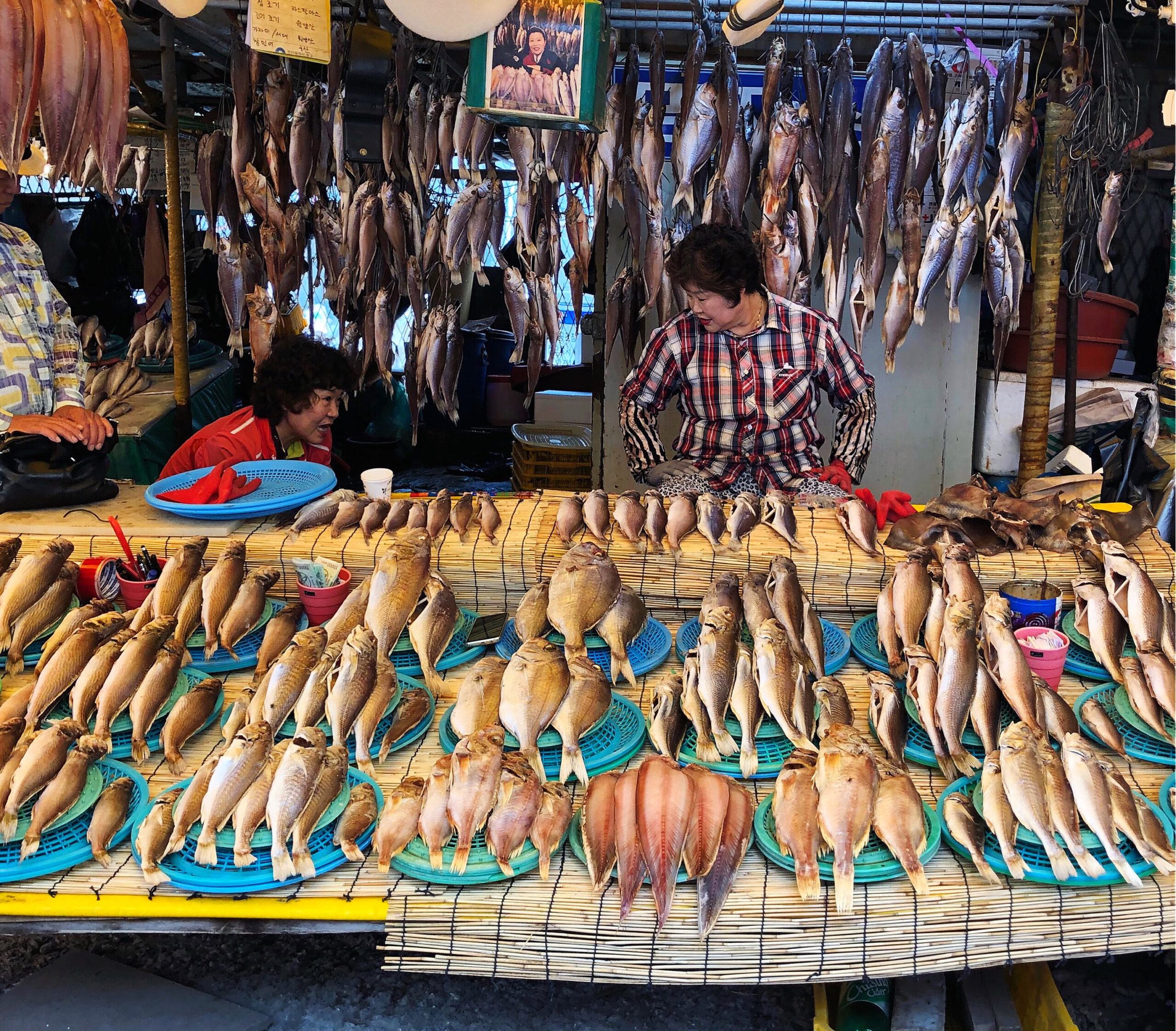
Grilled Shellfish in Cheongsapo (청사포), Busan
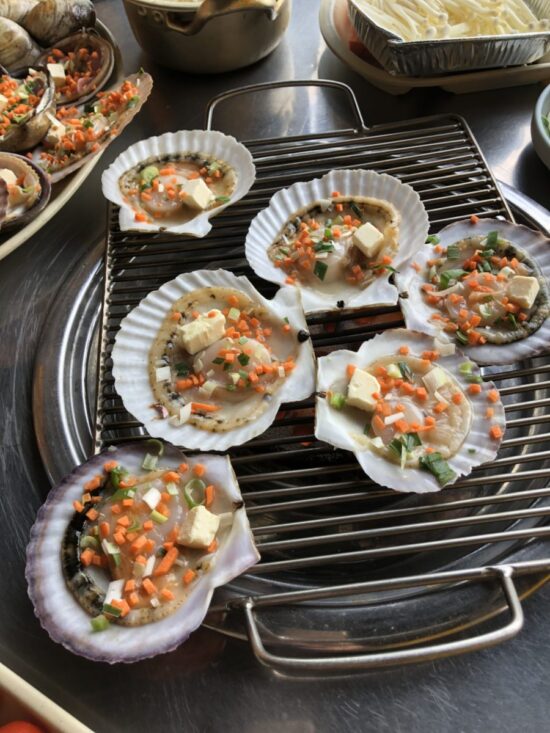
My wife’s all-time favorite, most ultimate meal in South Korea was grilled shellfish in Cheongsapo, Busan. Busan is a port city, and the local seafood options are out of this world! Honestly, even if you don’t love seafood, you should still visit because a meal in Cheongsapo may change your mind.
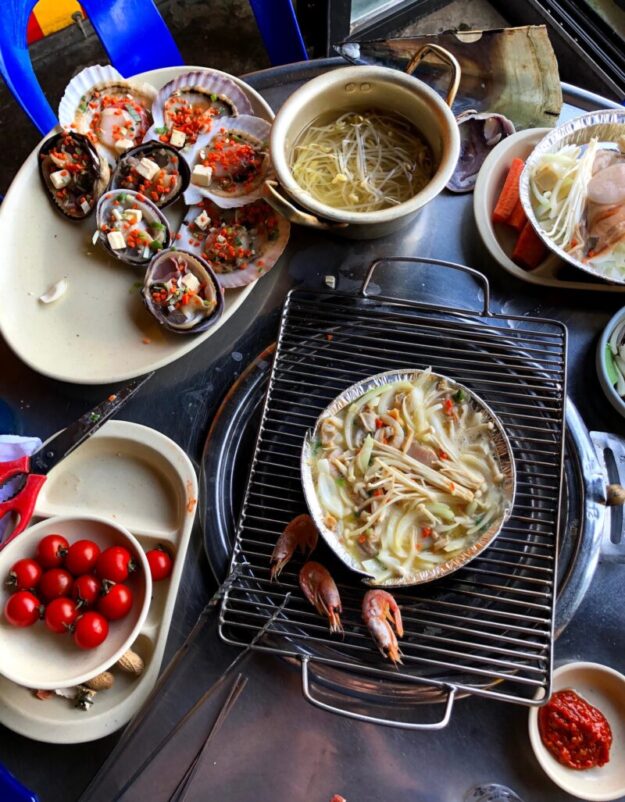
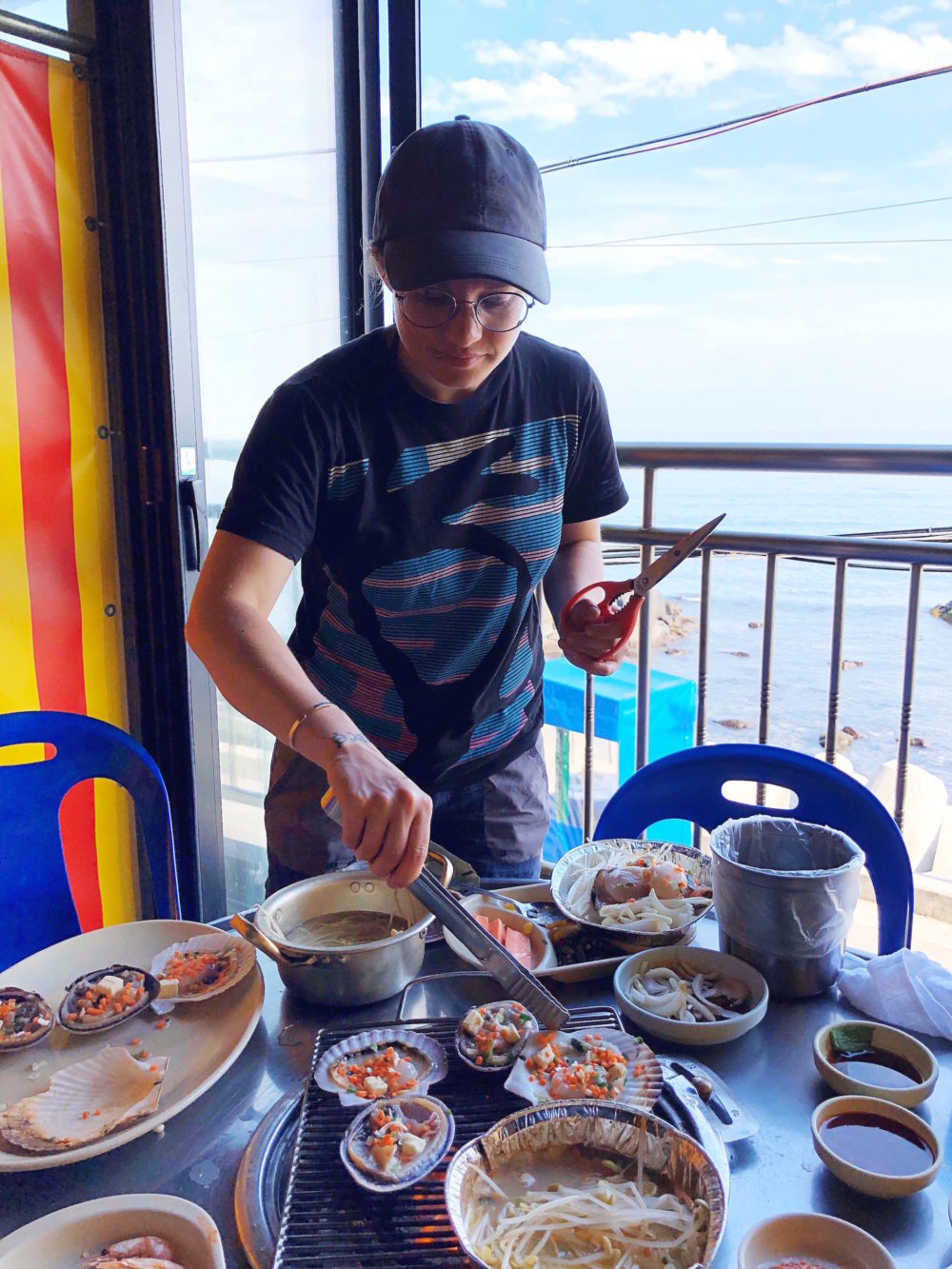
Head to Noran Mahura (노란마후라) for a lunch or dinner of barbecued shellfish that is to die for! The vibe is super casual, and you can enjoy a table looking right out onto the water. There’s a grill in the middle of the table, and you actually barbecue the meal right there in front of you. Choose from clams, oysters, shrimp, muscles and more. This is an especially great option for groups! Do not worry if you’ve never grilled shellfish yourself before. The staff will help you out.
Address: Noran Mahura (노란마후라) 60 Cheongsapo-ro 128beon-gil, Jung-dong, Haeundae-gu, Busan (부산광역시 해운대구 청사포로128번길 60)
Grilled with a mixture of butter, onion, carrots and mushrooms over an open flame. Noran Mahura was one of the best meals we had in South Korea!
A short taxi ride from Haeundae Beach, #Cheongsapo is best visited in the afternoon. On a sunny day walk along the fishing pier and to see Cheongsapo’s two lighthouses looking out over the Sea of Japan. #visitBusan
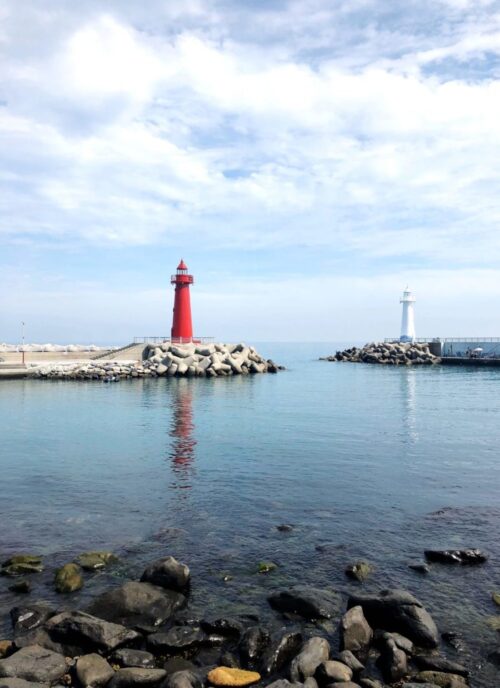
Pajeon (파전) - Scallion Pancake
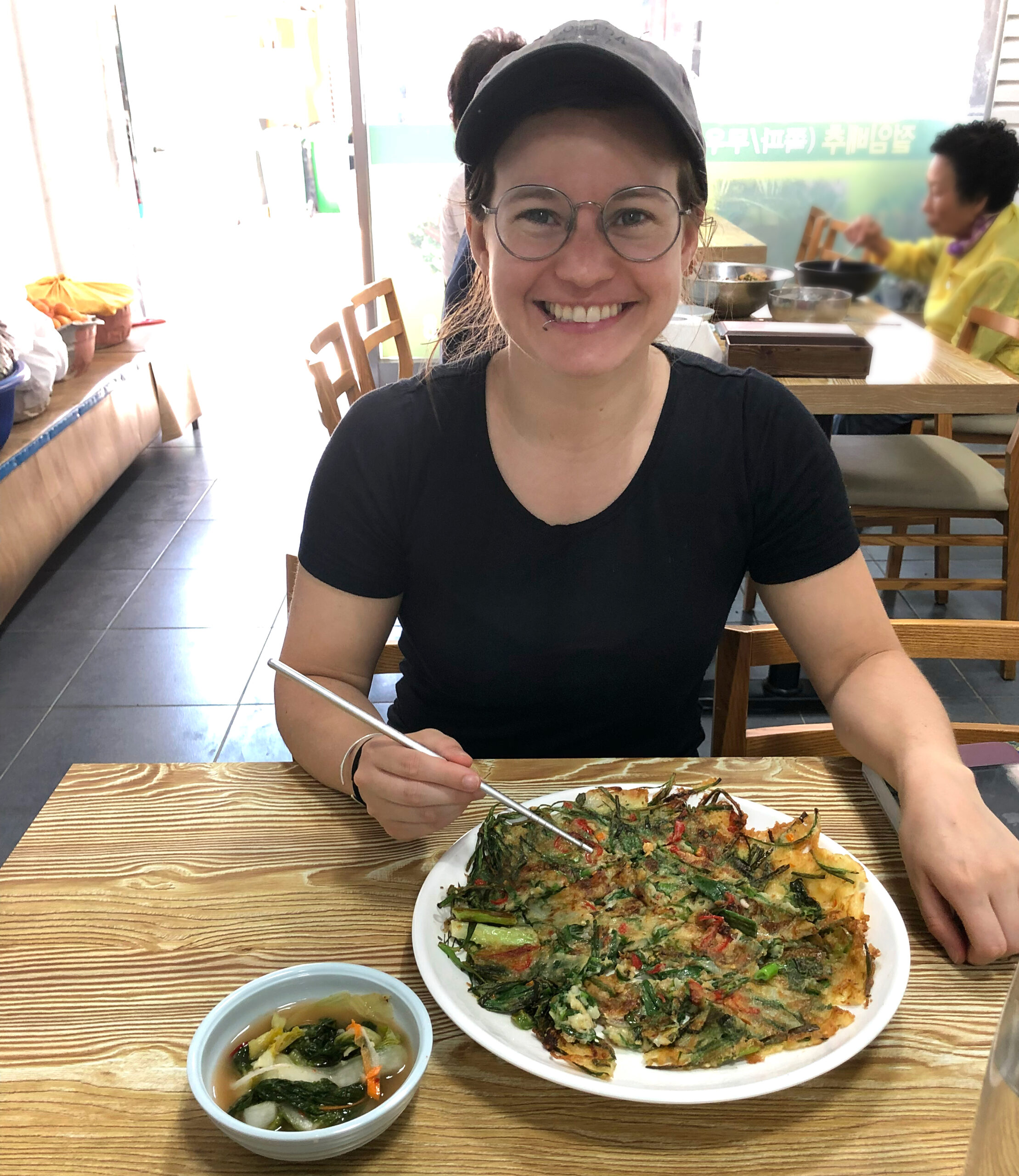
This simple Korean staple is packed with flavor! Made from a base of eggs, wheat flour & rice flour, add in ample scallions to bring out the unique and delicious flavor of pajeon. Throughout South Korea you can enjoy a variety of jeon and buchimgae variations, including beef, pork, kimchi, seafood and squid. ‘Pa’ is Korean for scallion, hence pajeon being specifically a scallion pancake. On our trip we enjoyed pajeon in restaurants and even learned to make the dish in a Korean cooking class!
What makes pajeon so flavorful is the amount of chopped scallions in the dish! Scallions are truly the dominant ingredient, just relying on the batter to hold the pancake together.
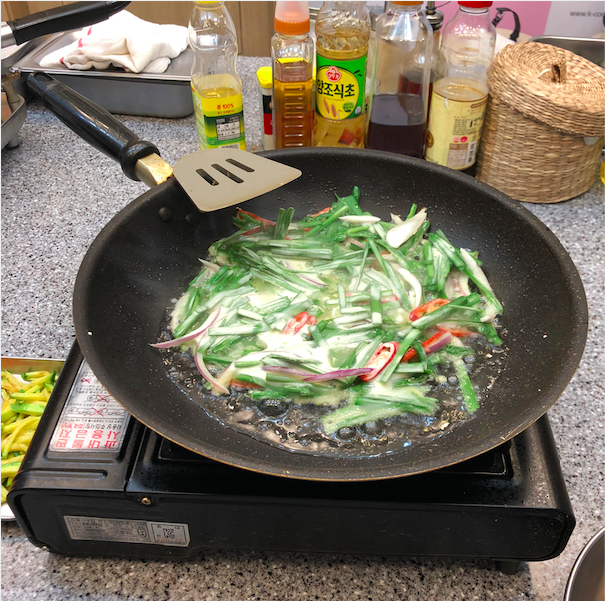
Are you heading to Busan? One of the top things to do in Busan is to visit Beomeosa temple. Waiting just beyond on the bus stop are a few local pajeon shops that I recommend you pop into for an afternoon snack! You won’t regret it. Note that the pancakes are pretty sizeable, so consider sharing one if you have a travel buddy.
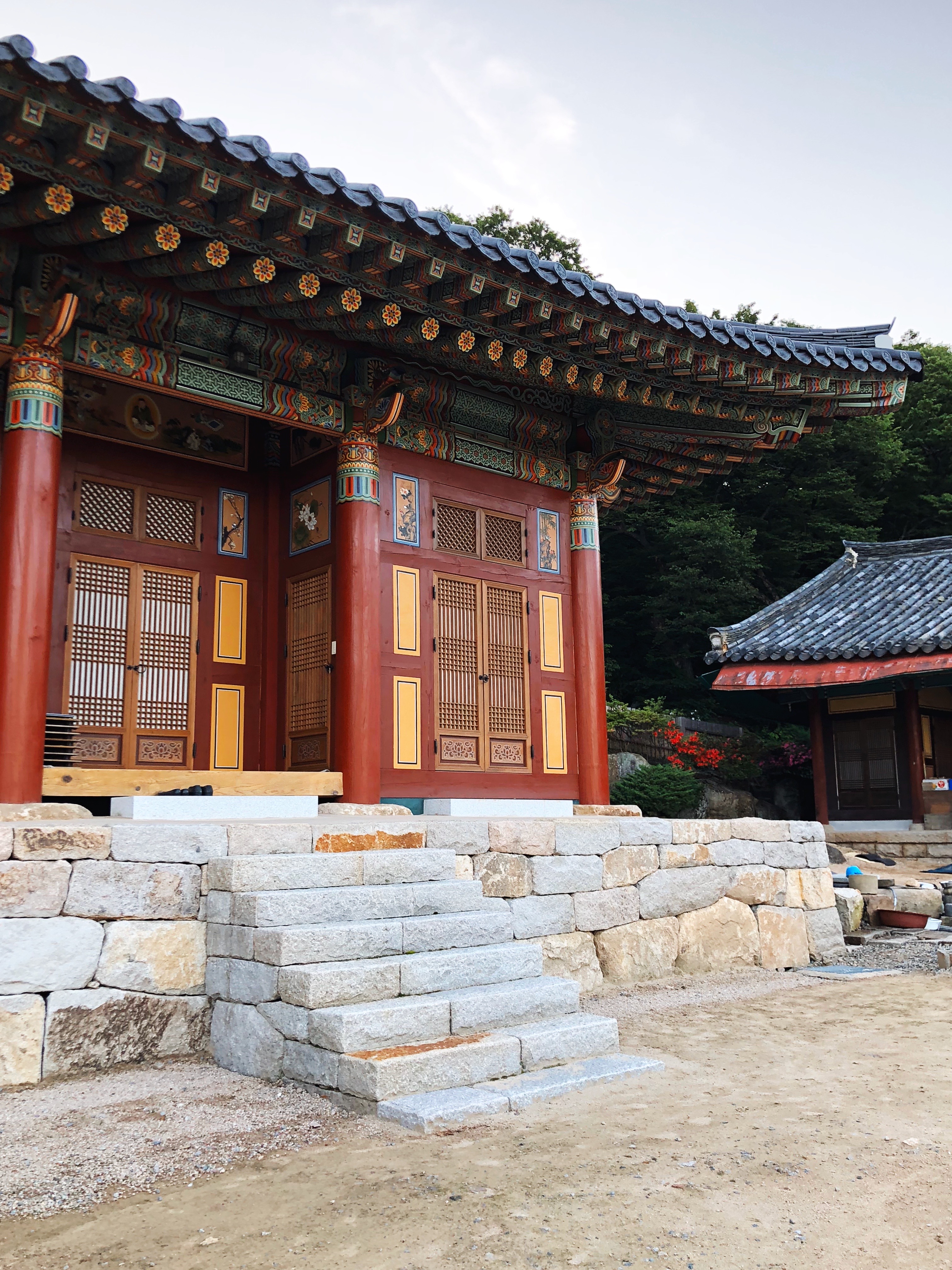
We started off our trip to South Korea with a breakfast in Seoul, including a kimchi pancake! Make sure to try this variety, too!
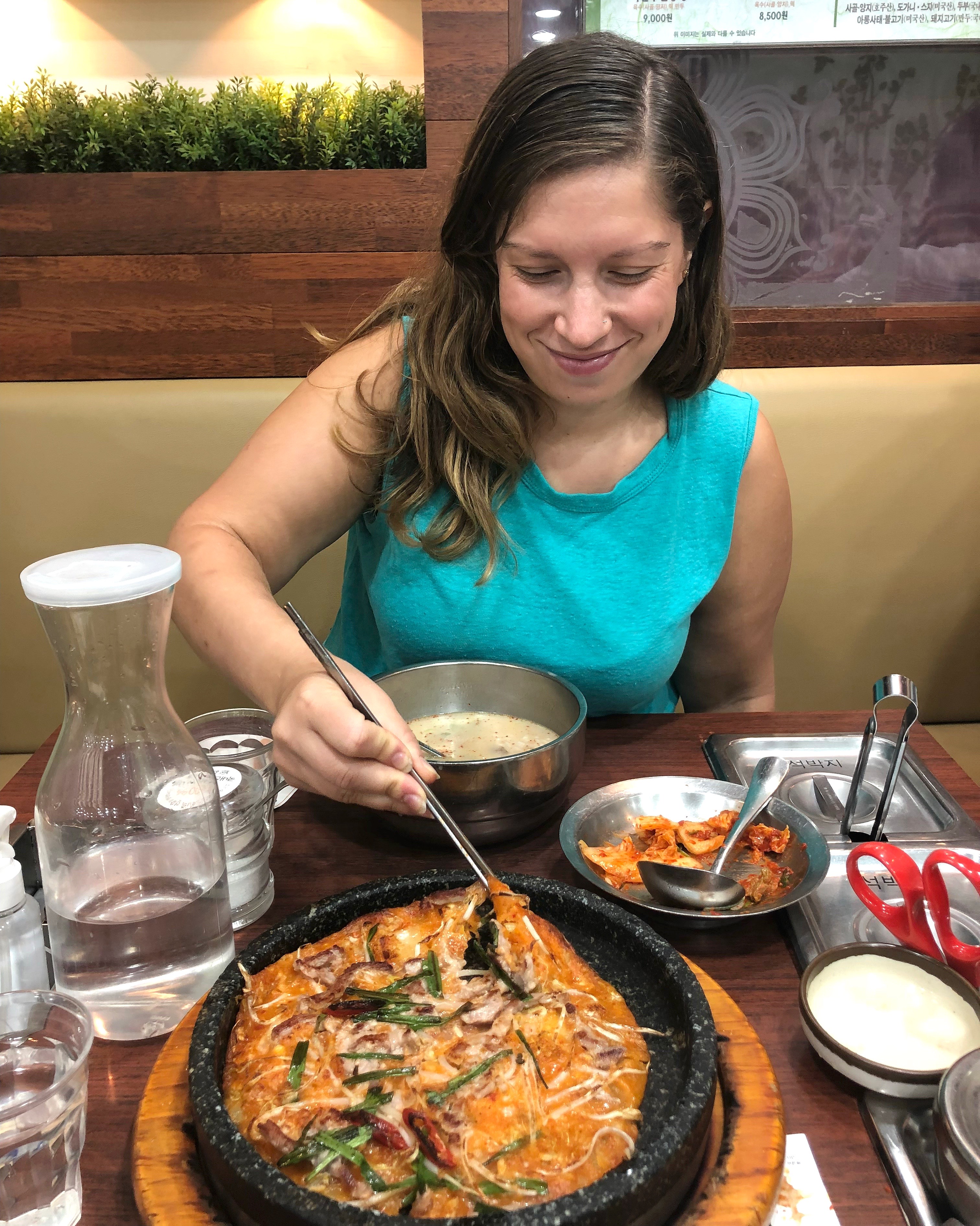
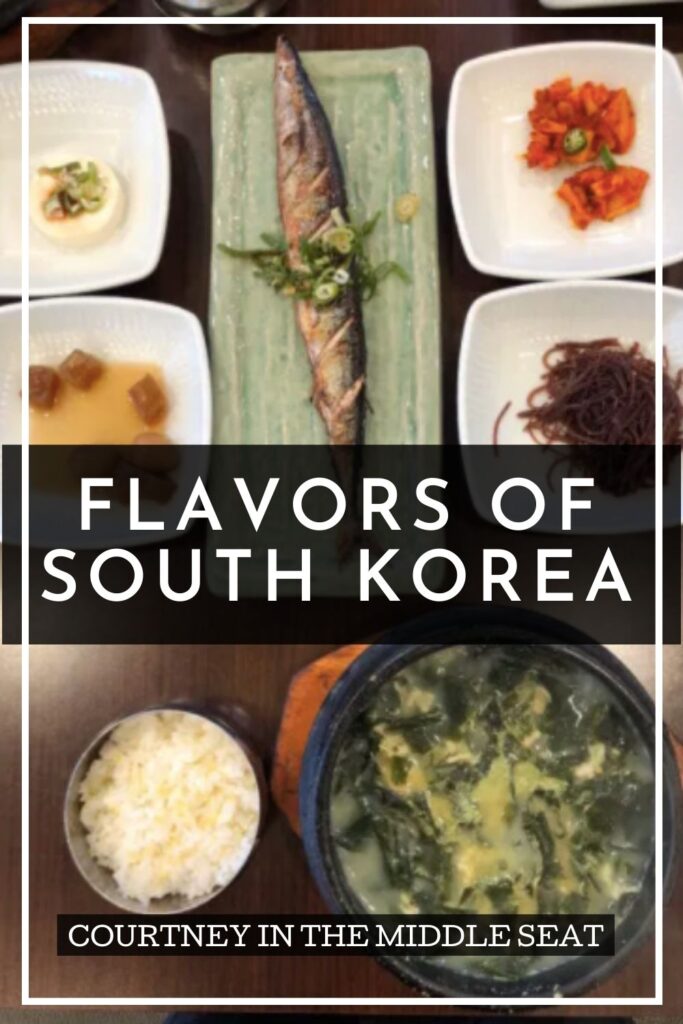
Like it? Pin it!
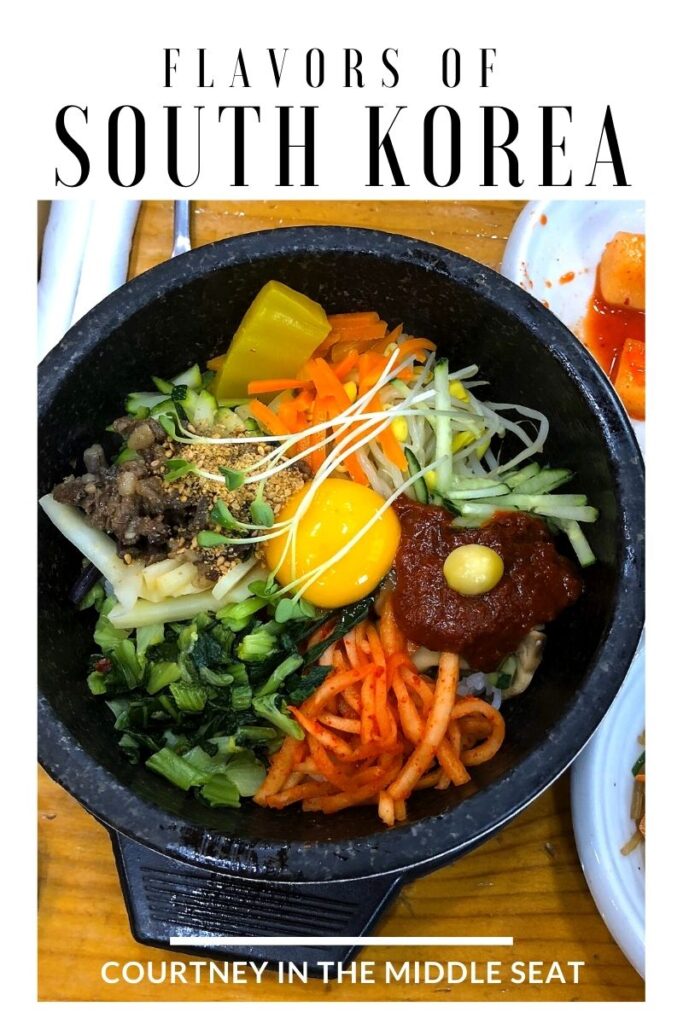
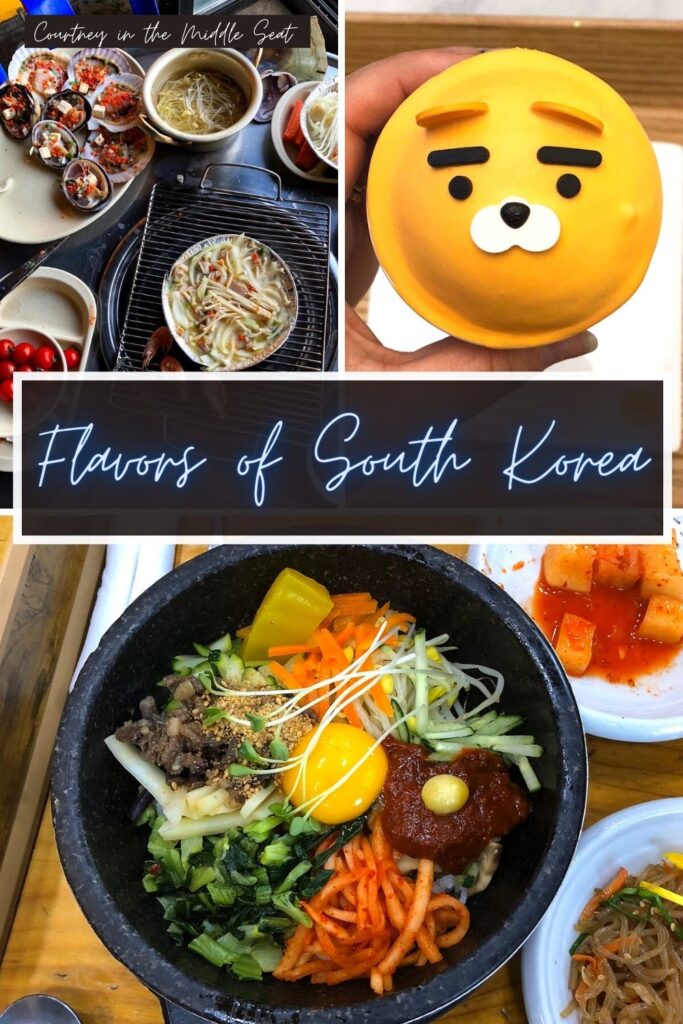
Flavors of Seoul
Seoul is where centuries of Korean history come face-to-face with a modern cityscape of skyscrapers and booming tech development. There is so much to see and do in Seoul, including plenty of Korean foods to try! We spent about 5 days exploring the city.
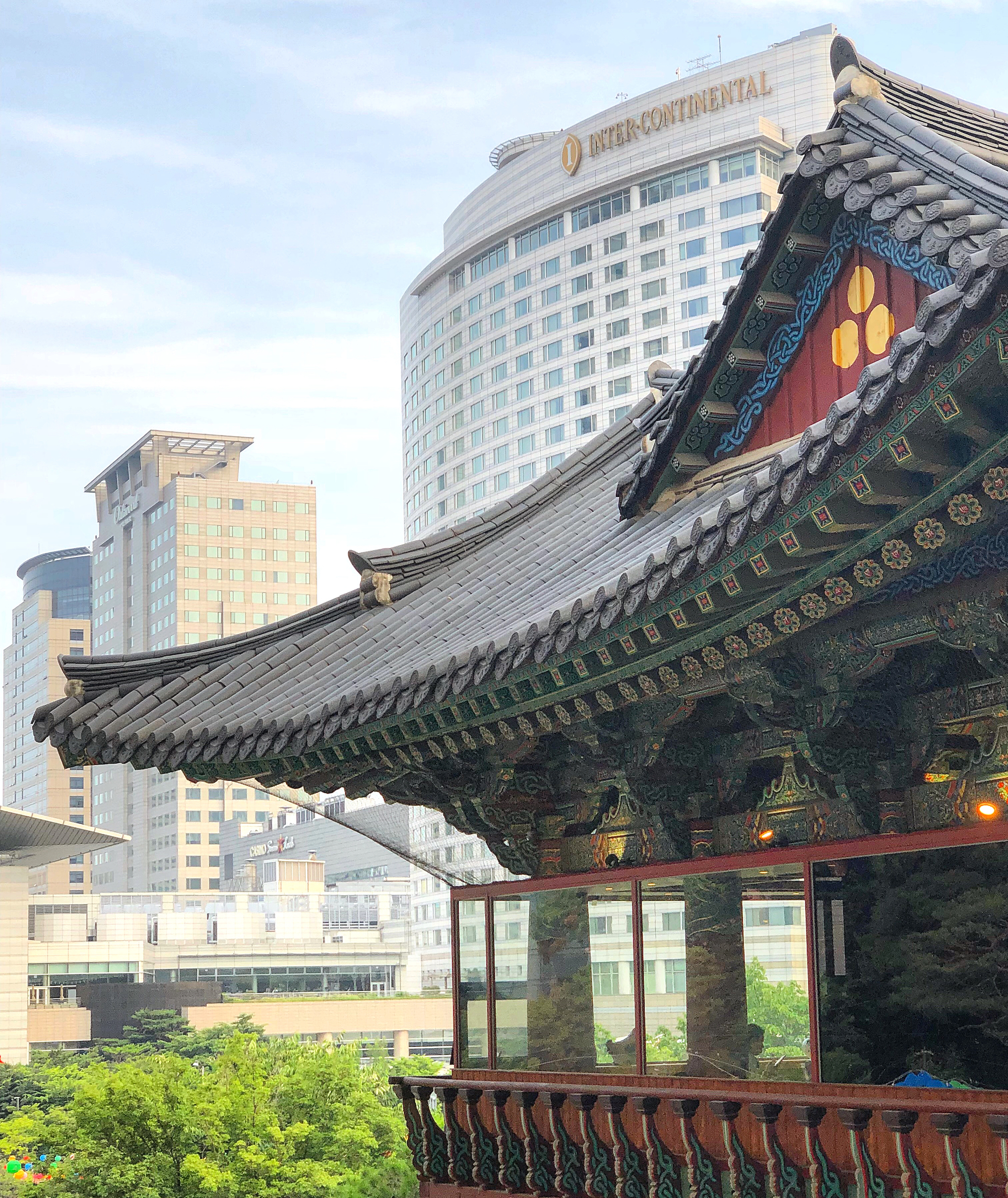
Kimchi Dumplings in Gwangjang Market
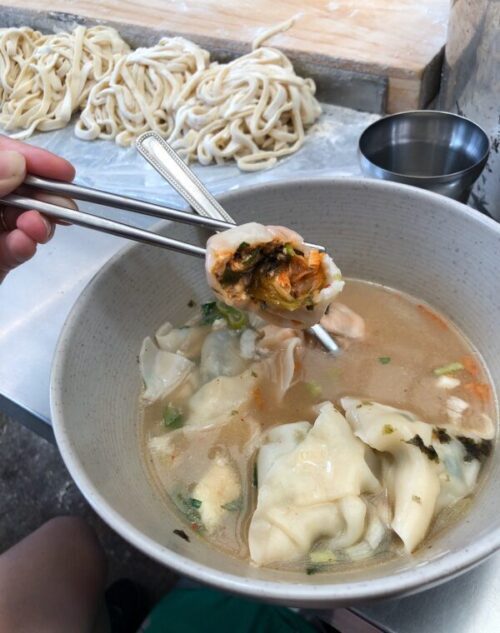
Gwangjang Market is one of Seoul’s largest outposts of traditional food vendors. With over 200 market stalls selling food, there are many awesome dishes to try! Gwangjang Market is a foodie marathon, not a sprint. On your short list should be a bowl of kimchi dumpling soup. These dumplings (or mandu in Korean) are usually made with a filling of kimchi, scallions, beansprouts, pork/tofu and onions. If you are a vegetarian confirm with the vendor whether or not their dumplings have meat.
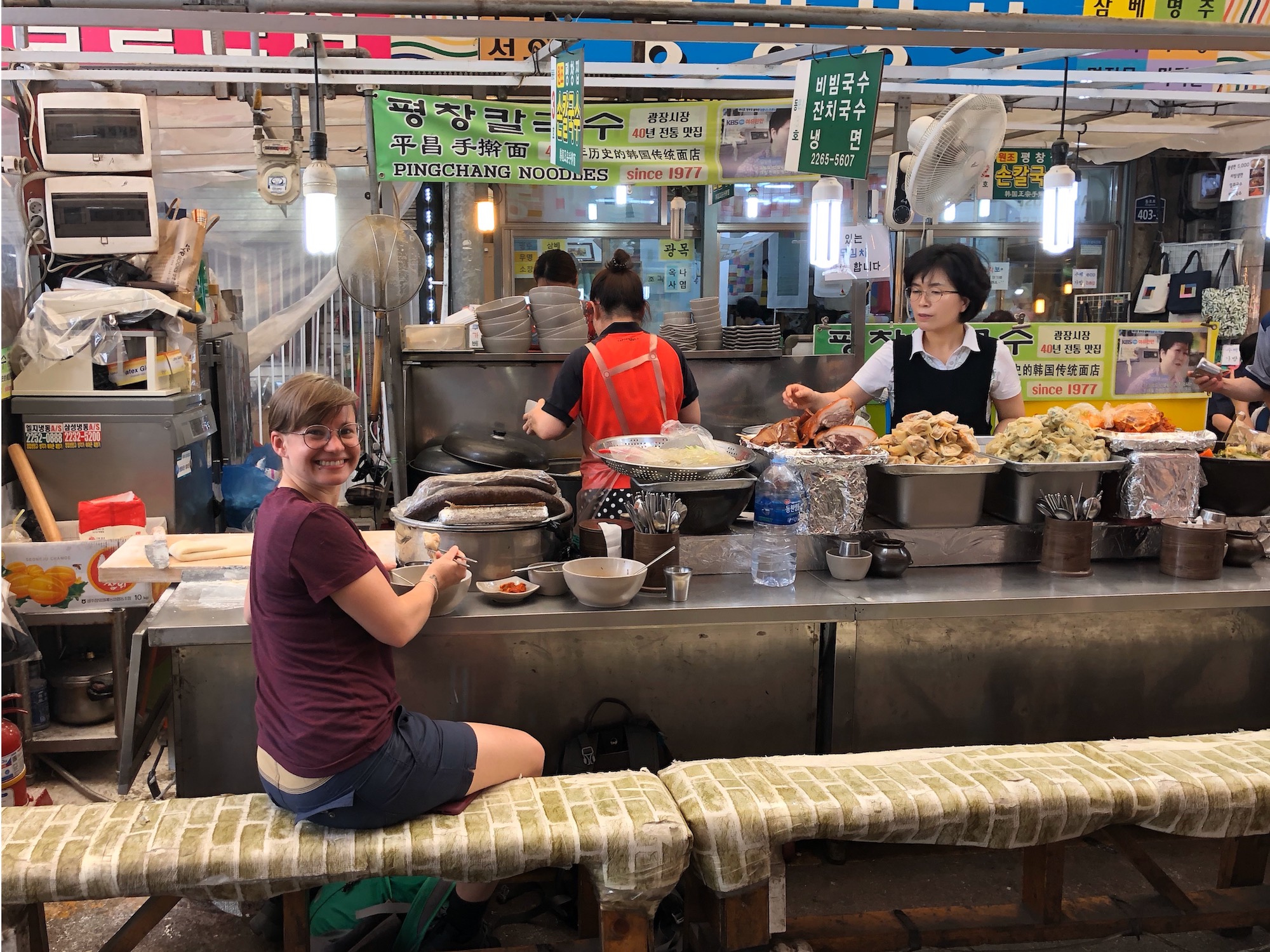
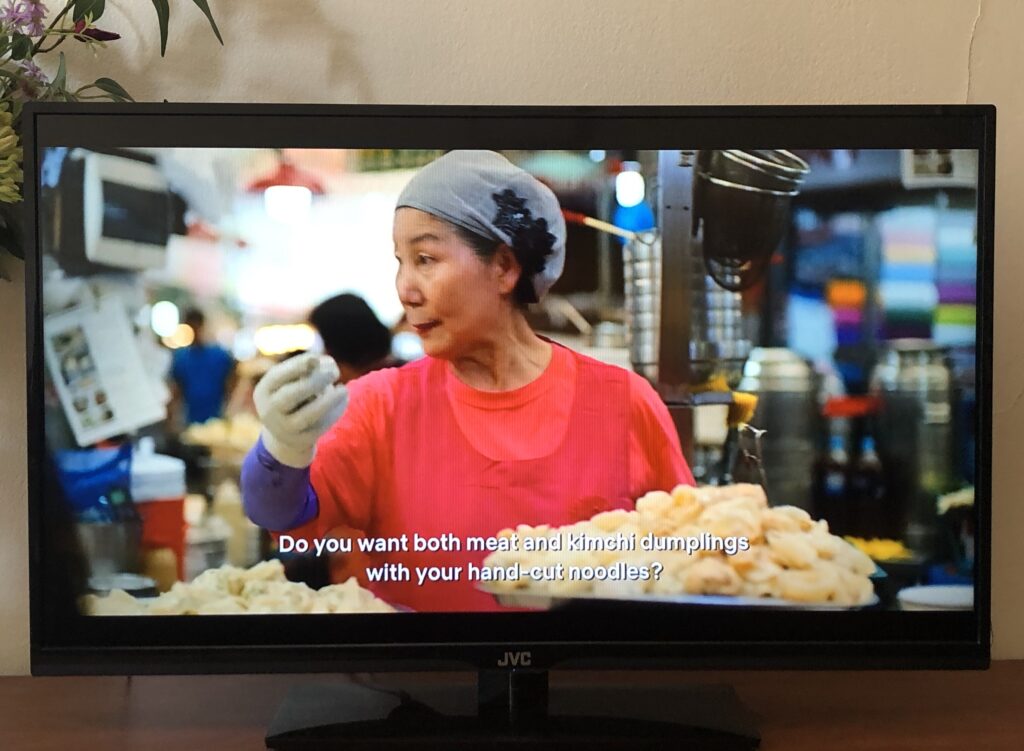
Gwangjang Market and kimchi dumplings from the Gohyang Kalguksu stall were recently featured on the Netflix Original Series Street Food: Asia. Accoring to the series, “Gwangjang Market is one of the best places for traditional Korean food in the country. It’s a chaotic paradise of food.” Make sure you are hungry when you are arrive, but also remember to pace yourself.
As you walk through Gwangjang Market be prepared for sensory overload in the most delicious way possible. Many stalls offer quick snacks to go while you walk. Or, pull up a bench and sit for down for a steamy bowl of mandu with hand cut noodles. The experience of watching noodles cut right in front of you, feeling the aromatic steam from boiling pots and hearing the sizzle of freshly frying treats is something you will remember long after your visit!
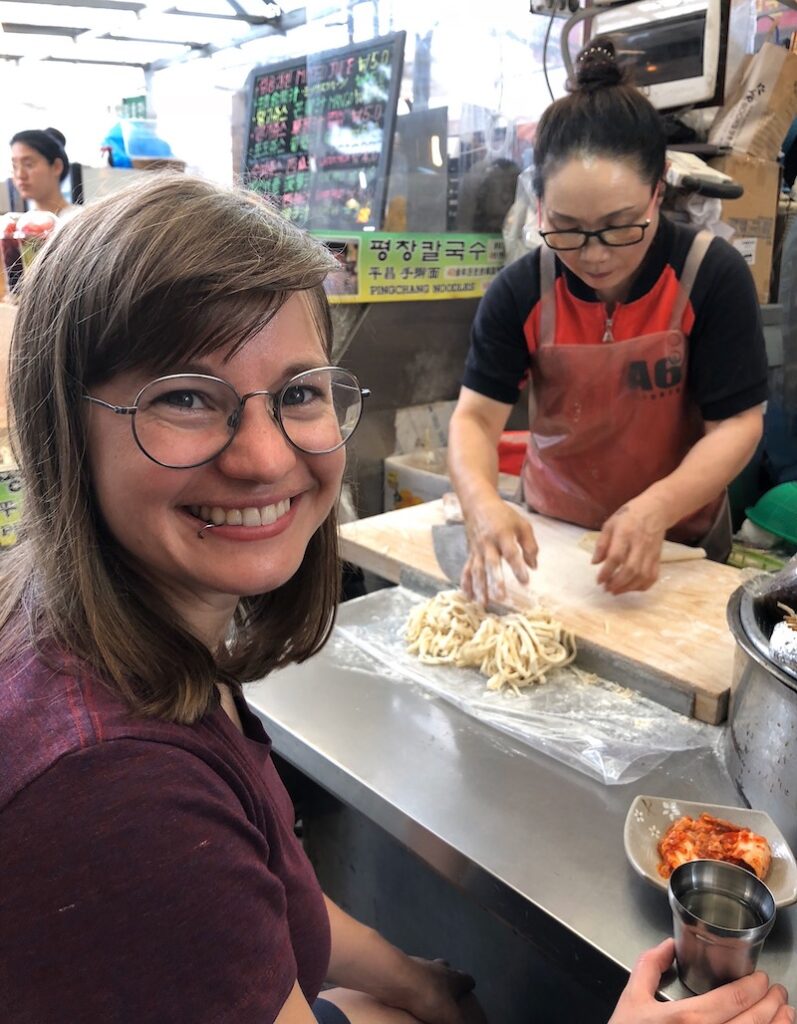
Also transliterated as Kwangjang Market, it is one of Seoul's oldest traditional markets still in use today! There are over 5,000 shops selling everything you can imagine from food to vegetables, clothing, home goods and more.
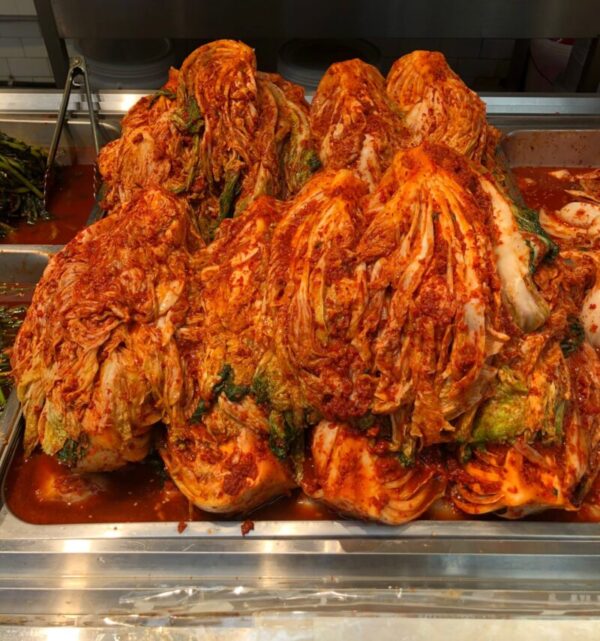
Another Korean favorite is the mung bean pancake, or bindae-tteok. First, mung beans are soaked and then finely ground using a traditional stone grinder. Vegetables, meat, and spices are then mixed in, and the batter is poured onto a hot cooking surface covered in oil. Bindae-tteok are warm and flavorful. They were not my personal favorite, but are definitely worth trying!
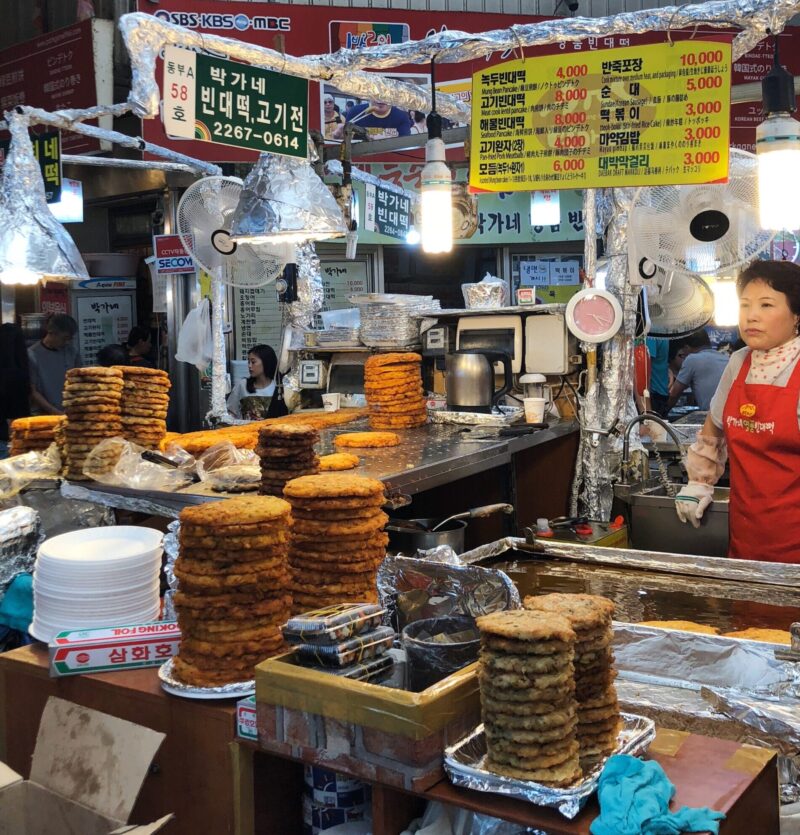
Samgyetang (삼계탕) - Korean Ginseng Chicken Soup
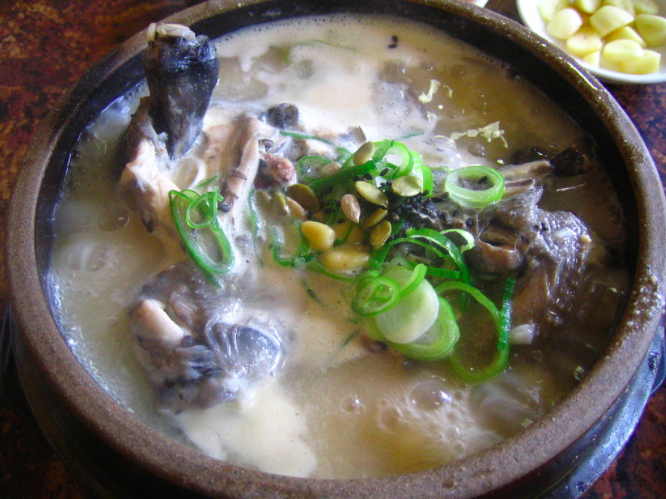
Ginseng is revered as a power-packed herb offering numerous health benefits in traditional medicine across Asia. For centuries Koreans have taken ginseng to alleviate an array of health issues from the common cold to longer-term illnesses. Ginseng is also the preeminent ingredient in samgyetang, or ginseng chicken soup. Samgyetang is traditionally prepared by cooking a whole young chicken in a broth flavored with ginseng, garlic, jujube and sometimes scallions or additional ingredients.
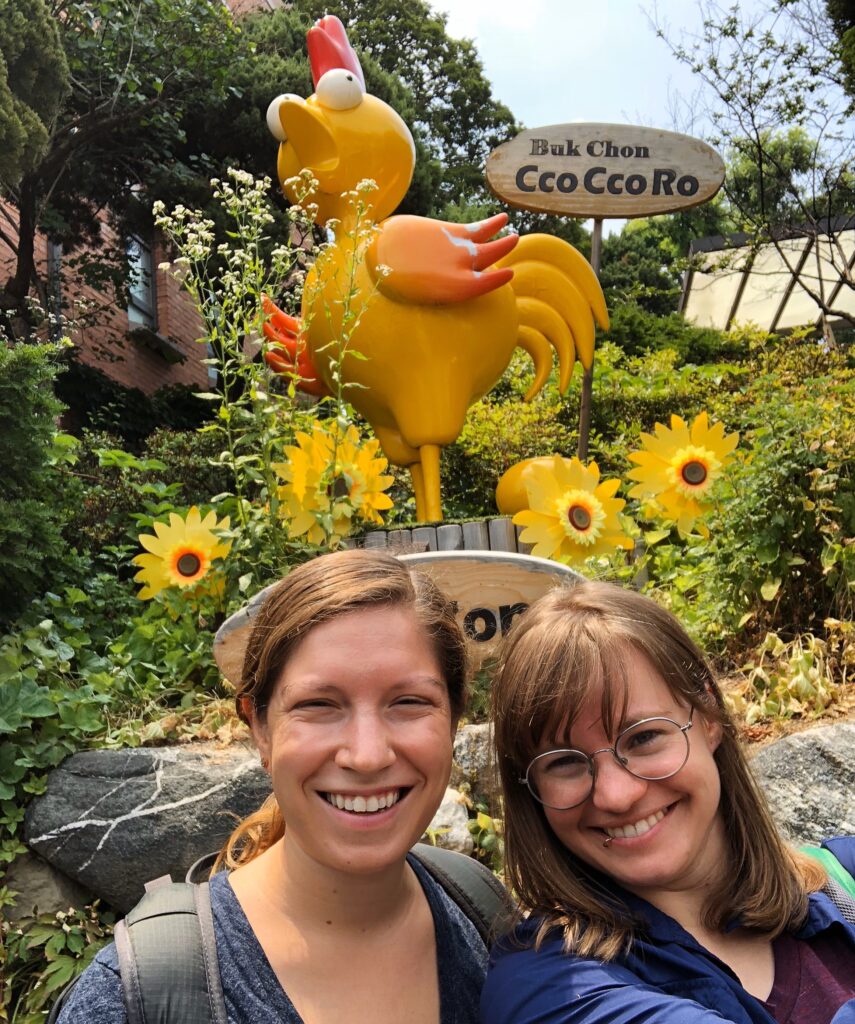
Eating a bowl of samgyetang is said to give you a health boost, and I can see why. This warm soup is definitely comforting and filling, but doesn’t leave you feeling heavy or weighed down. I really enjoyed trying samgyetang, but my wife wasn’t thrilled. If you’re exploring Seoul’s Bukchon Hanok Village, stop by Cco Cco Ro for a bowl of samgyetang. The restaurant is touristy, but it is an easy spot to try this classic Korean dish. And capture a post-ginseng selfie at their ridiculous chicken “Photo Station”.
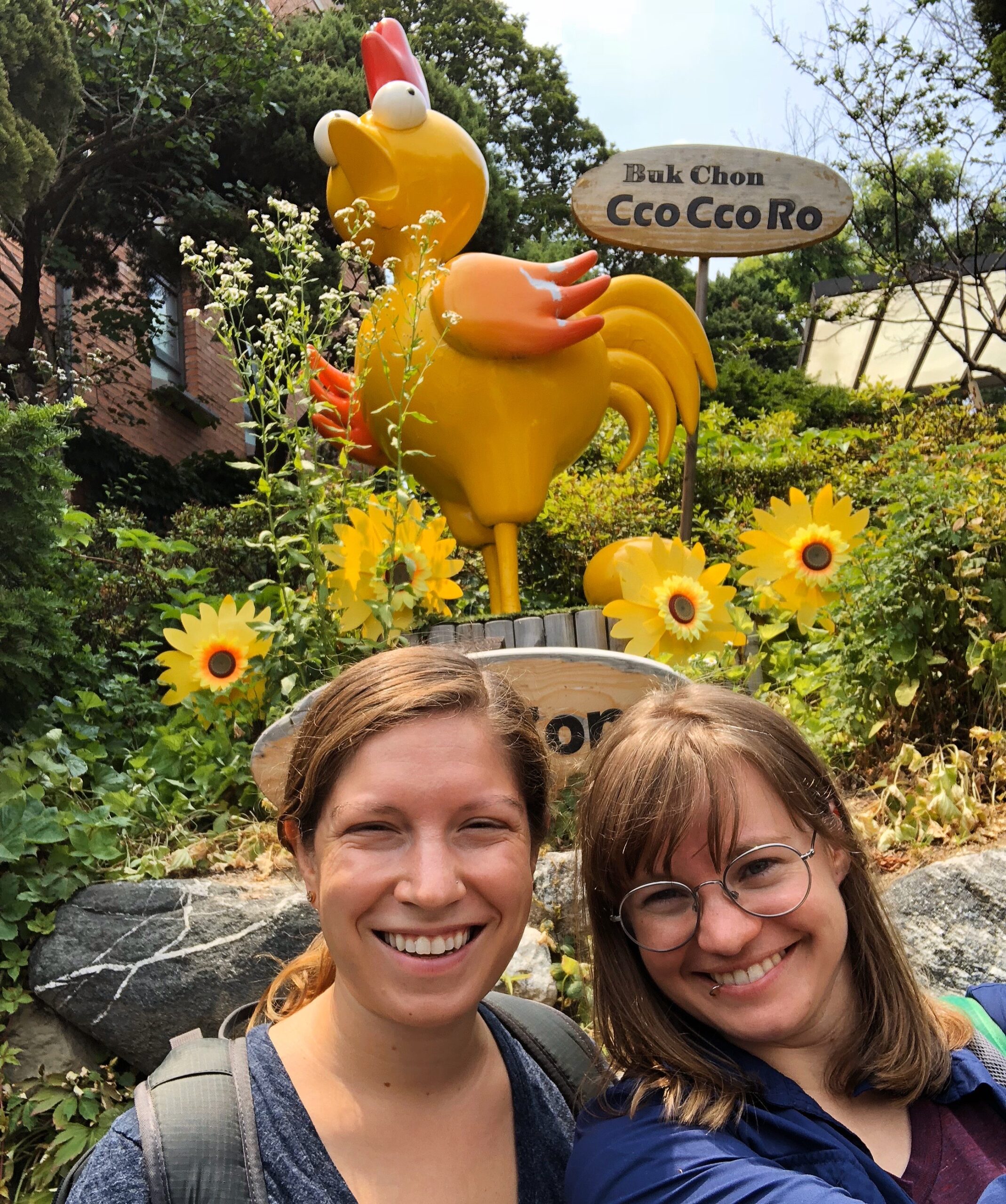
If you’re booking an organized tour from Seoul (shopping tours, visits to the DMZ, etc.), your tour will probably stop at the Korean Ginseng Center. This is a bizarre, yet memorable spot. The Center is a ginseng cheerleading tour-processing factory that is basically a hype man extolling the virtues of Korean ginseng. We did actually learn a bit about the history of ginseng and how it is grown, but the propaganda is a bit overwhelming.
Incheon - Home to South Korea's Largest Chinatown
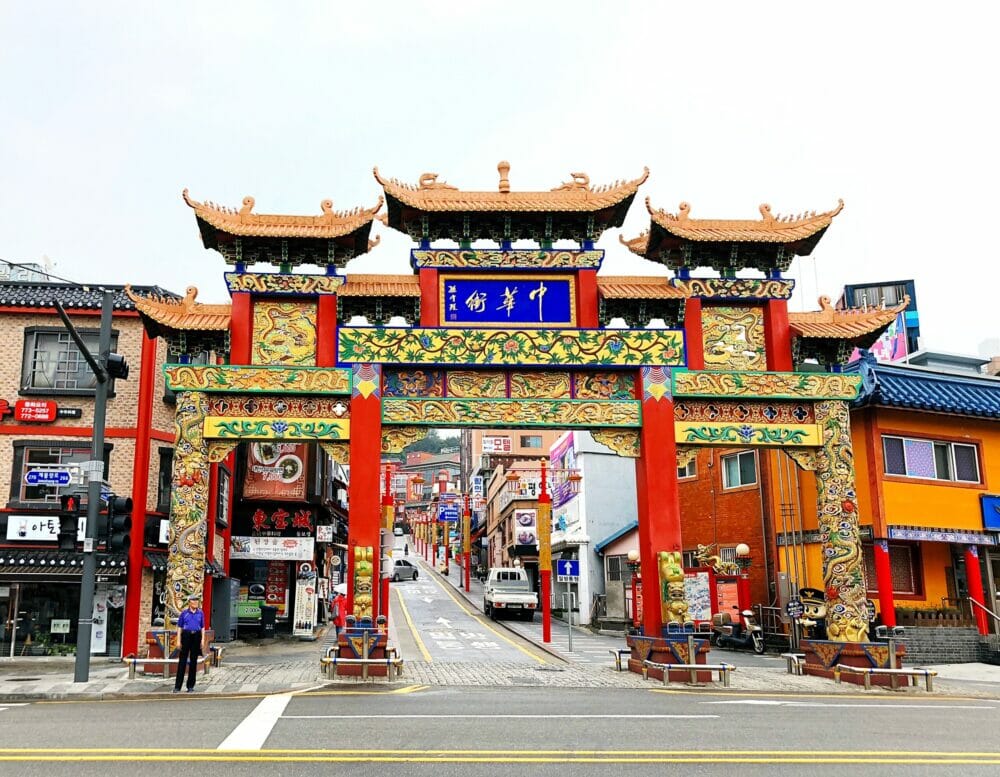
Bordering Seoul to the west is Incheon, home to South Korea’s only official Chinatown! You may well be flying in or out of Incheon International Airport on your visit to South Korea, but the city is worthy of a visit on it’s own. (Especially if you’re a history-loving foodie like me!)
Jjajangmyeon (짜장면)
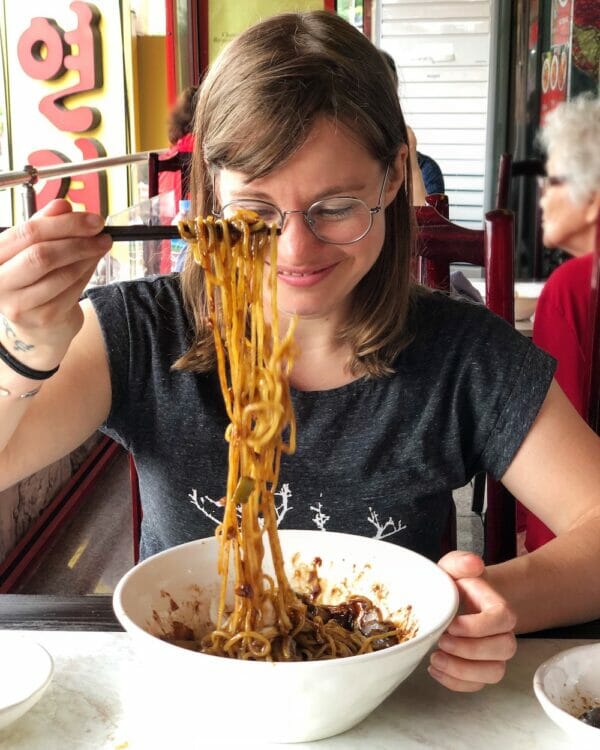
Jjajangmyeon (or jajangmyeon) is a noodle dish topped with diced pork, vegetables and the signature sauce made of chunjang, a thick dark brown paste made from fermented wheat flour and soy beans. Jjajangmyeon is the Korean adaptation of zhájiàngmiàn (炸酱面), or “noodles with soybean paste” from the Eastern Chinese Province of Shandong. Today, you can visit the the city of Incheon, home of South Korea’s largest Chinatown and where jjajangmyeon originated in 1905!
Incheon is the perfect day trip from Seoul! Explore Chinatown, take photos at Fairy Tale Village selfie spots and stroll along the boardwalk! Incheon is located just outside Seoul and is easily accessible by the metro.
What started as a low-cost meal for Chinese port workers in Incheon has evolved into the staple meal of South Korea’s unofficial, KPop-inspired holiday: Black Day. Black Day is the tragic sister holiday to Valentine’s Day to all the Korean singles. According to the NY Times Magazine columnist Sam Sifton, “Those unencumbered by dates or romance are meant to gather in their sharpest, blackest outfits and eat one of Korea’s great comfort foods, jajangmyeon, a thick, coal-colored gravy of black-bean sauce, pork and onions ladled over fat noodles and served with sweet pickled daikon.”
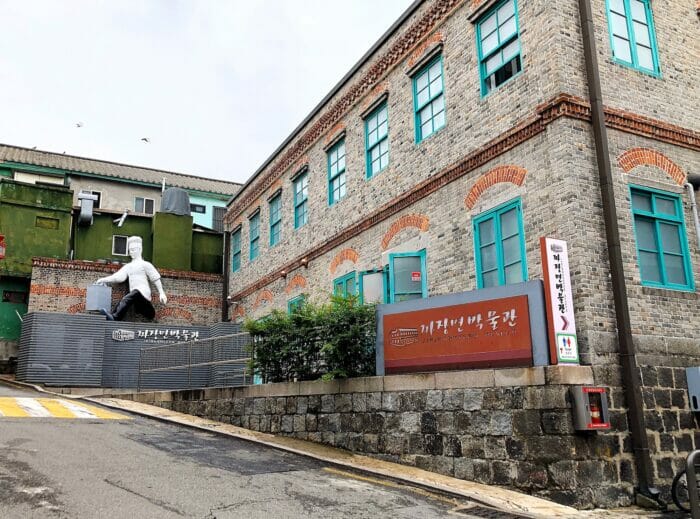
Jjangmyeon Museum
The Jjanjangmyeon Museum is located in the building of the former Gonghwachun Restaurant where the dish was first served! Head to the museum to learn more about the history of this famous dish and how it is interwoven with Chinese influence in South Korea.
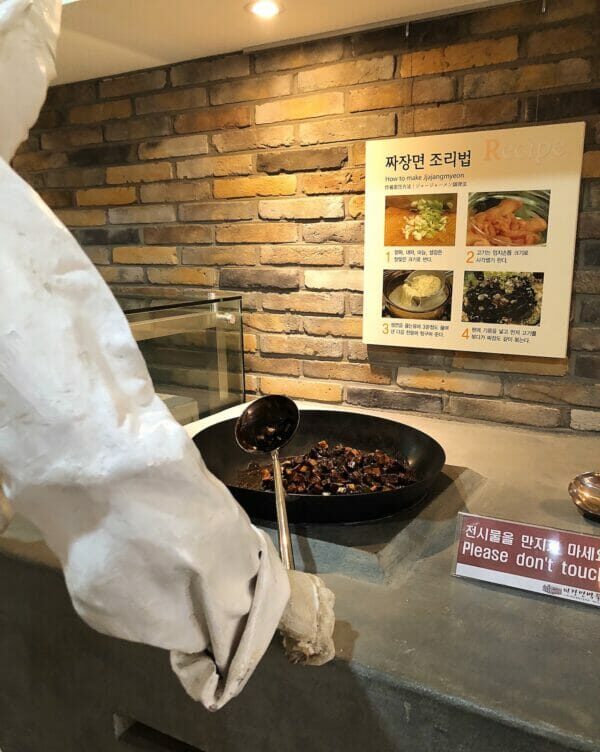
What’s even better than learning about the history of jjajangmyeong? Actually giving it a try! Head just down the street to Gonghwachun for a big, warm bowl of noodles. This isn’t the original restaurant, but the jjajangmyeong is 100% authentic and a must-try if you’re in Incheon. Gonghwachun’s 4-story building offers seating along the balcony so you can enjoy great views of Chinatown during your meal.
Flavors of Jeonju
Jeonju is one of the culture and food capitals of South Korea! In 2012 it was designated as a member UNESCO’s Creative Cities Network for Jeonju’s gastronomic contributions to the country! Creative cities are identified as places where creativity and the arts are considered major factors contributing the city’s economic development plan.
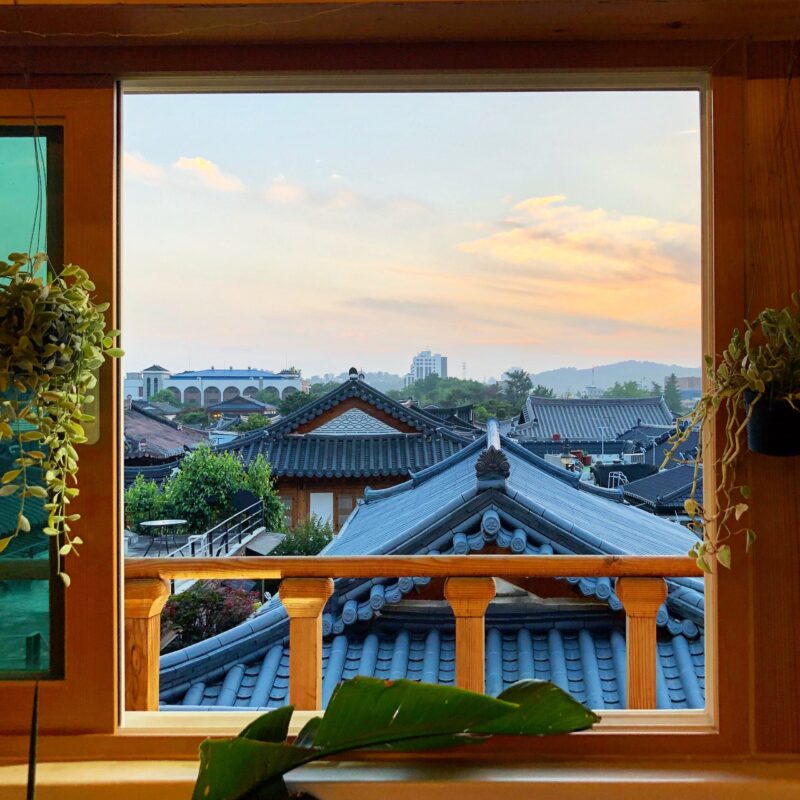
Bibimbap (비빔밥) in Jeonju
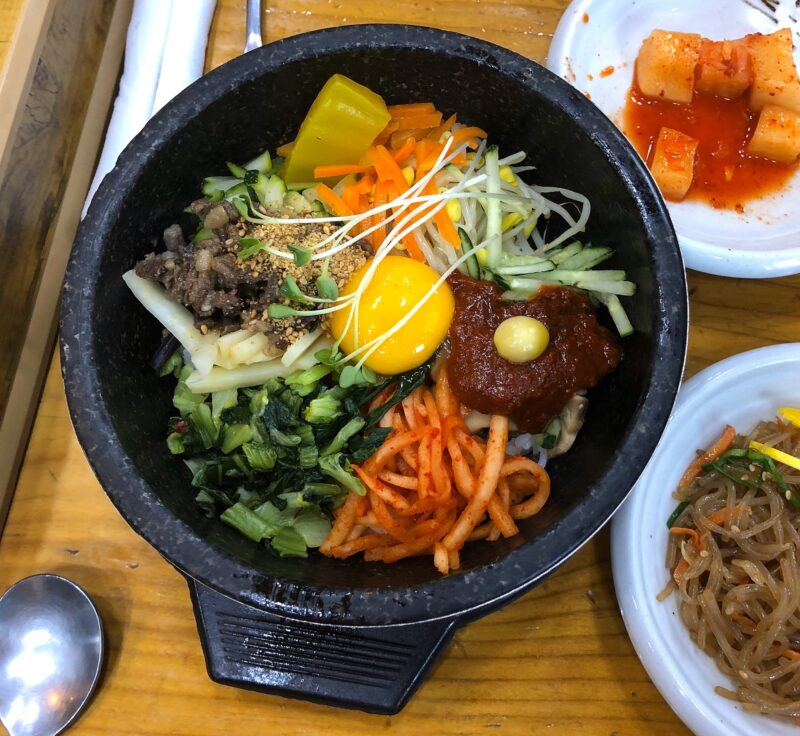
Bibimbap is one of the most famous Korean dishes known around the world! Starting with base of warm white rice, sauteed vegetables, kimchi, gochujang and often egg and/or meat are then placed on top. When served each ingredient is separated, reminding me of a winning Trivial Pursuit game piece. But, makes sure it mix it up before you enjoy! There are different varieties of bibimbap, and the city of Jeonju is known for this signature dish.
Jeonju Bibimbap is made using rice cooked with bean sprouts and beef broth. (yuuuummmmm) In Jeonju your rice will be topped with a rainbow of ingredients including carrots, seaweed, bean sprouts, red pepper paste, beef and spinach.
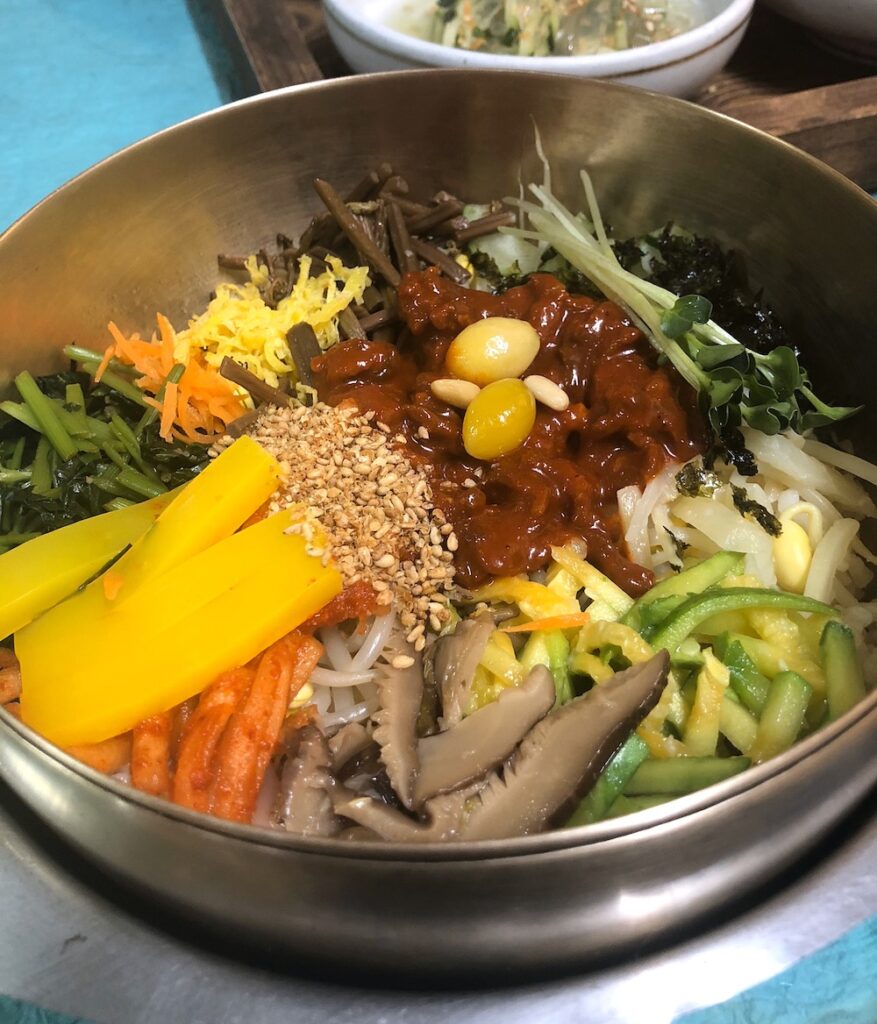
The origins of bibimbap are debated, but it is recorded to have been eaten at the royal court during Korea's Joseon Dynasty. The Yi clan, founders of the Joseon Dynasty, trace their roots to Jeonju, creating the link between this popular Korean dish and the city.
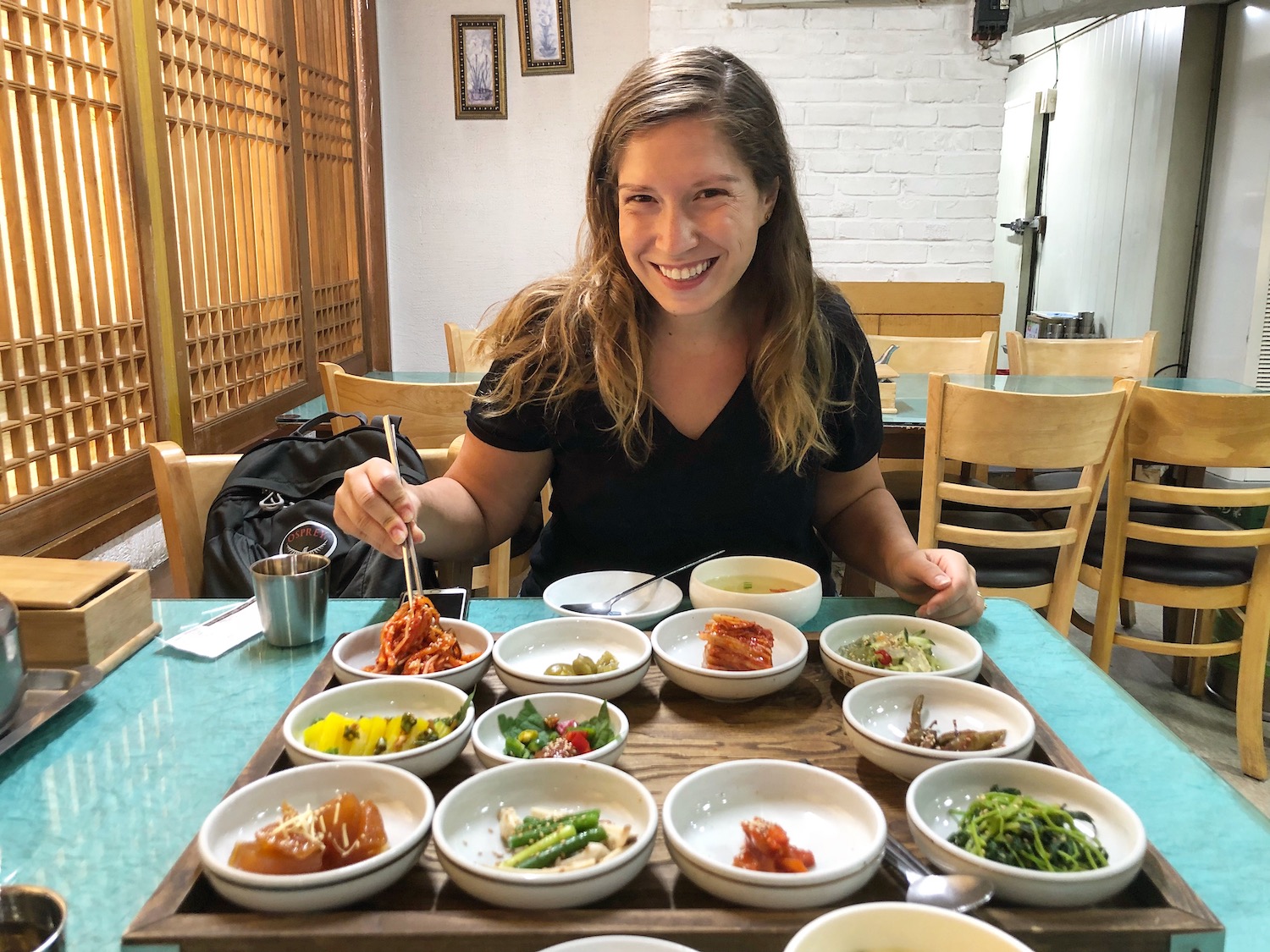
Where to Eat Bibimbap in Jeonju - Jungang Hoegwan
For authentic Jeonju Bibimbap, head to Jungang Hoegwan! Almost even more impressive than the main dish itself, is the array of banchan that precedes the main dish! (Don’t be confused, there is a separate restaurant named “Jeonju Jungang Hoegwan in Seoul that is very popular.)
Address: 78-1 Jungangdong 3(sam)-ga, Wansan-gu, Jeonju-si, Jeollabuk-do, South Korea
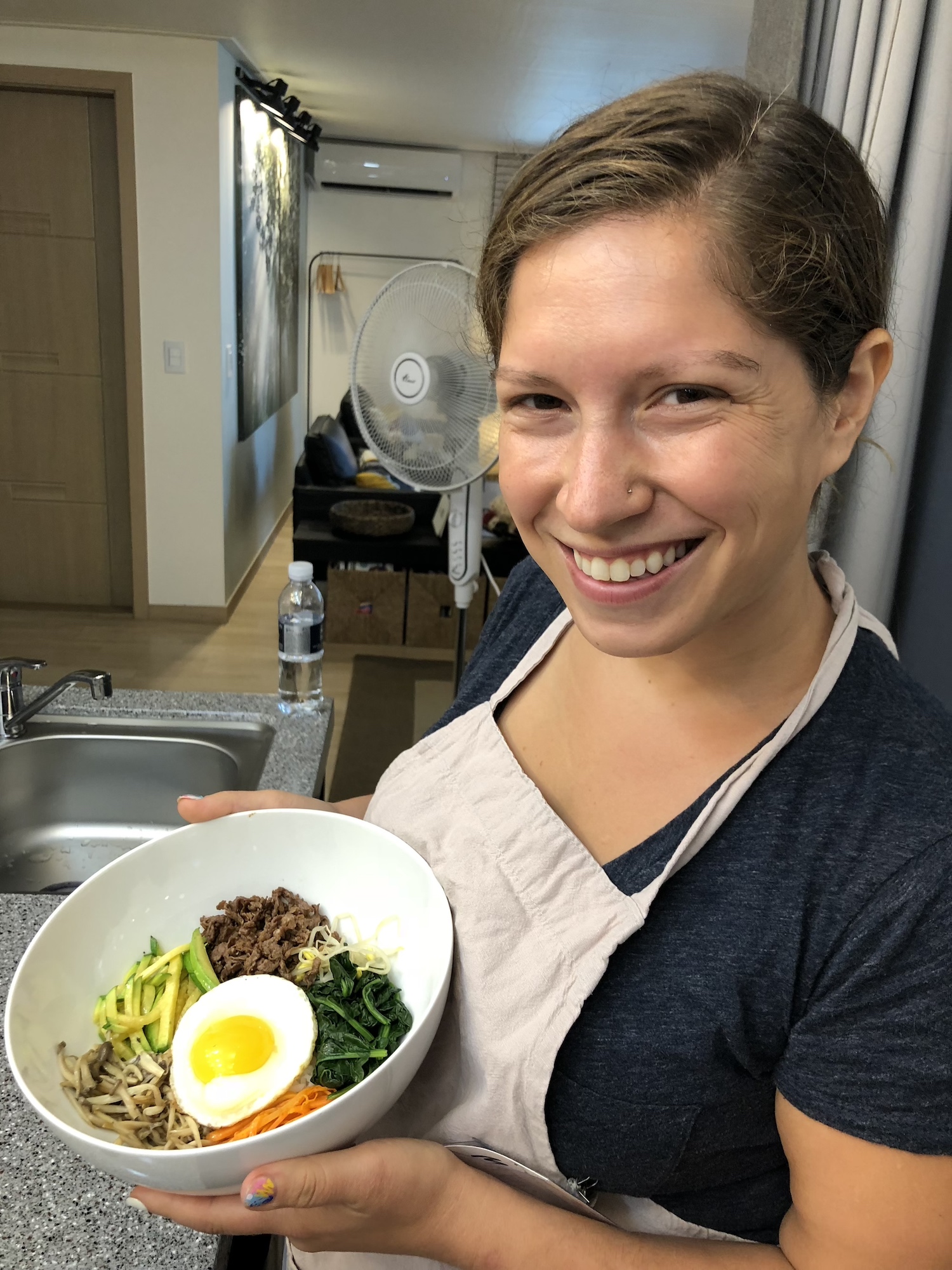
Learn to Make Bibimbap in a Cooking Class!
If you’re as excited about bibimbap as I am, take a cooking class and learn to make it yourself! We joined a class in Seoul with K-cookingclass, and it was a fantastic experience! Our class started with a local market tour where we were introduced to local fruits and vegetables. We then learned to make a few dishes including pajeon and bibimbap. The class is very hands on, and Chris the instructor really took time to answer all of our questions and share insight into both Korean history and modern Korean culture. Classes are capped at 6 people, so it really is an individualized experience!

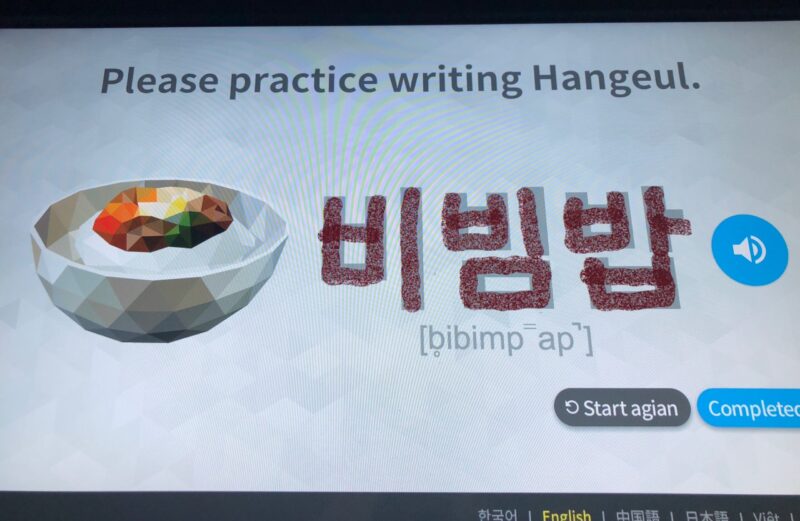
You can even learn to read and and write ‘bibimbap’ in Korean characters at the National Hangeul Museum in Seoul. (I highly recommend visiting!)

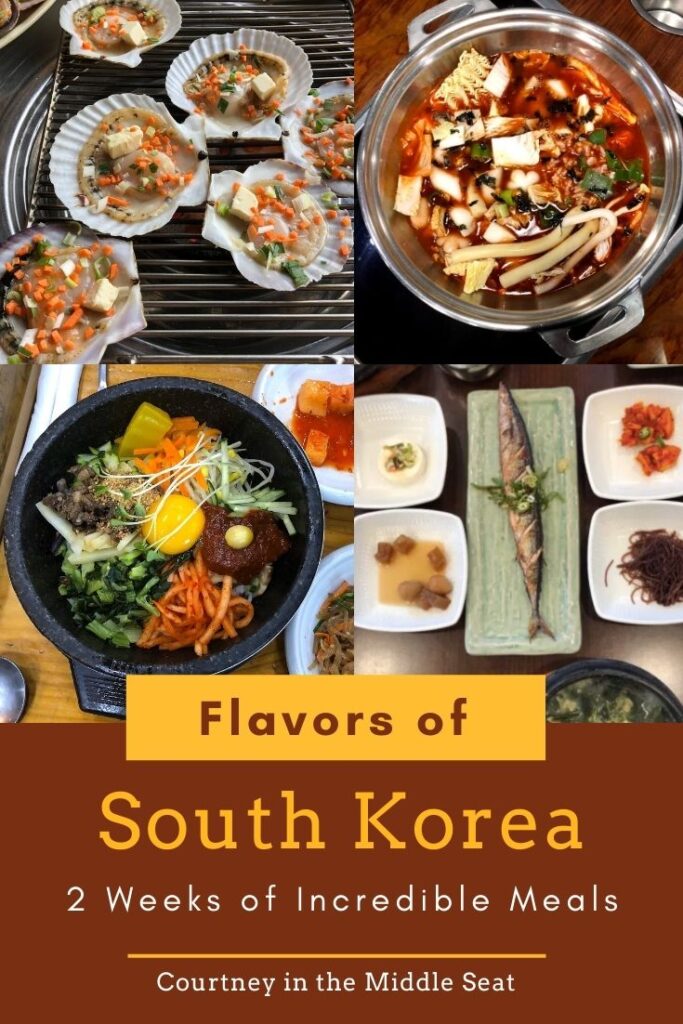
Like it? Pin it!

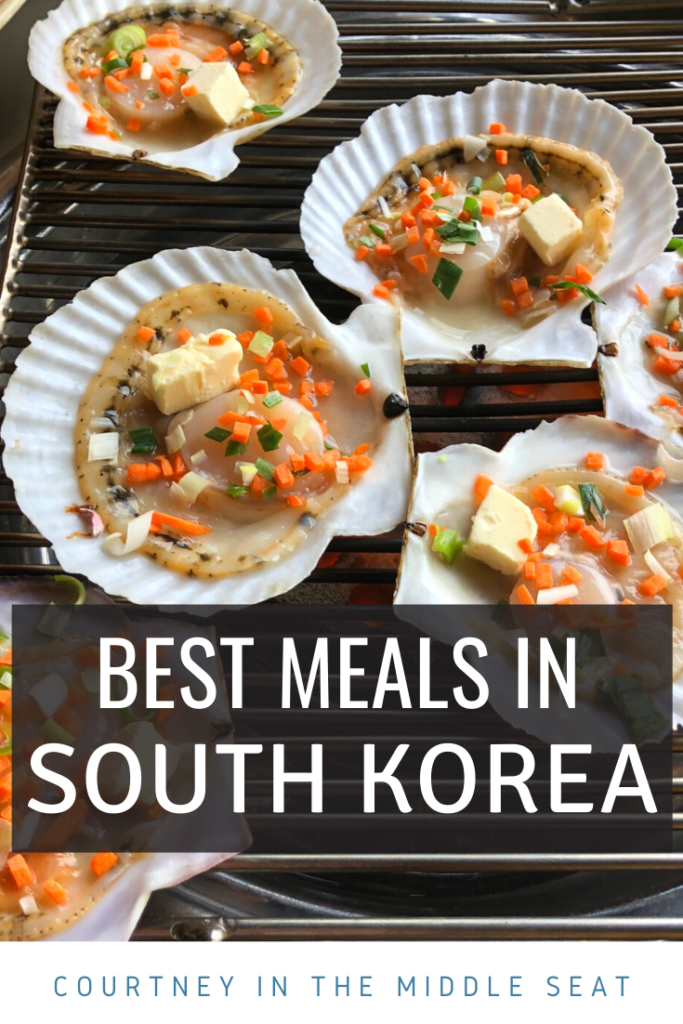
Kongnamul Gukbap (콩나물국밥) - Bean Sprout & Rice Soup at Hyundai-ok in Nambu Market
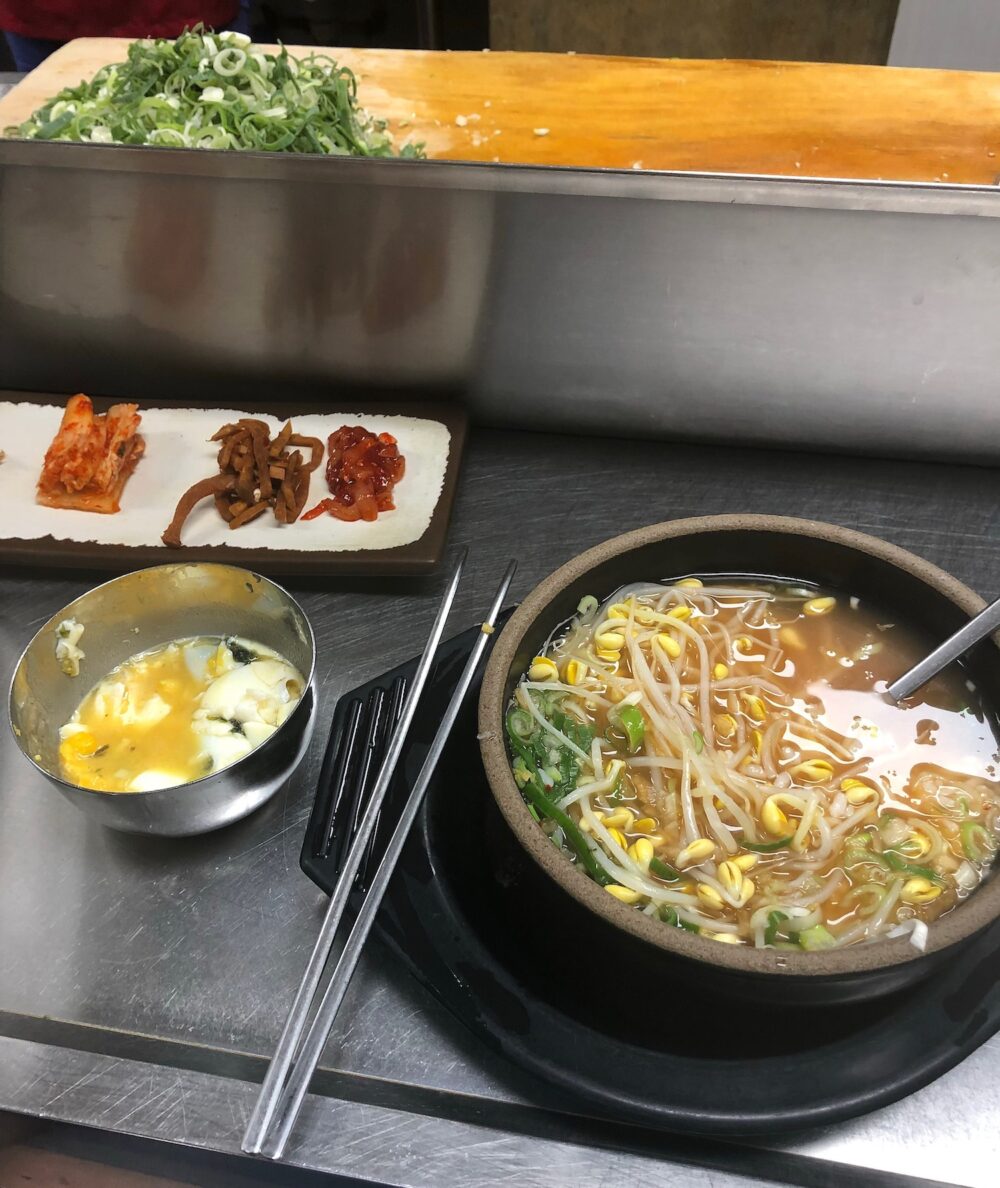
If you’re visiting Jeonju, plan time to visit Nambu market for a bowl of steaming bean sprout & rice soup at Hyundai-ok. It is nestled among the winding corridors of vendors selling everything from fruits and vegetables to home goods, clothing and more. It may take a bit of searching to find, but a warm, steaming bowl of kongnamul gukbap is worth it! Hyundai-ok is open from 6 am to 2 pm (as of July 2018), but ask about hours before heading there. We went for breakfast, and it was great!
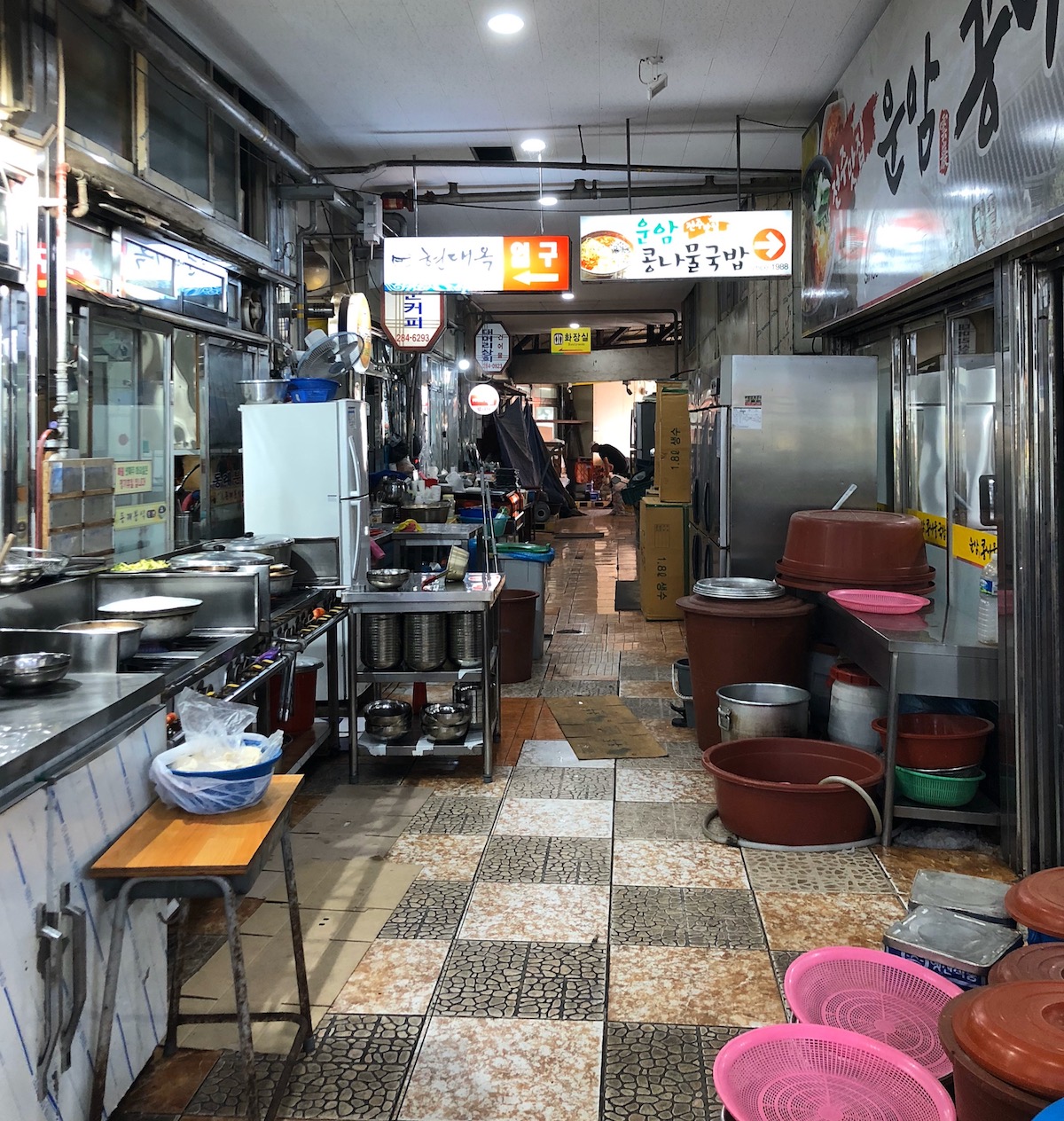
Flavorful broth filled with bean sprouts and rice, this soup’s flavor is enhanced with scallions, chilis and garlic! You will actually see the ingredients being freshly chopped right in front of you. Add a bit of kimchi and seaweed for more flavor! At Nambo Market, Hyundai-ok makes their kongnamul gukbap by adding chilled rice and bean sprouts into a pot and then ladling the cooked broth on top. This helps to preserve the texture of the rice and the crispness of the bean sprouts since these ingredients are not sitting in the broth as it boils.
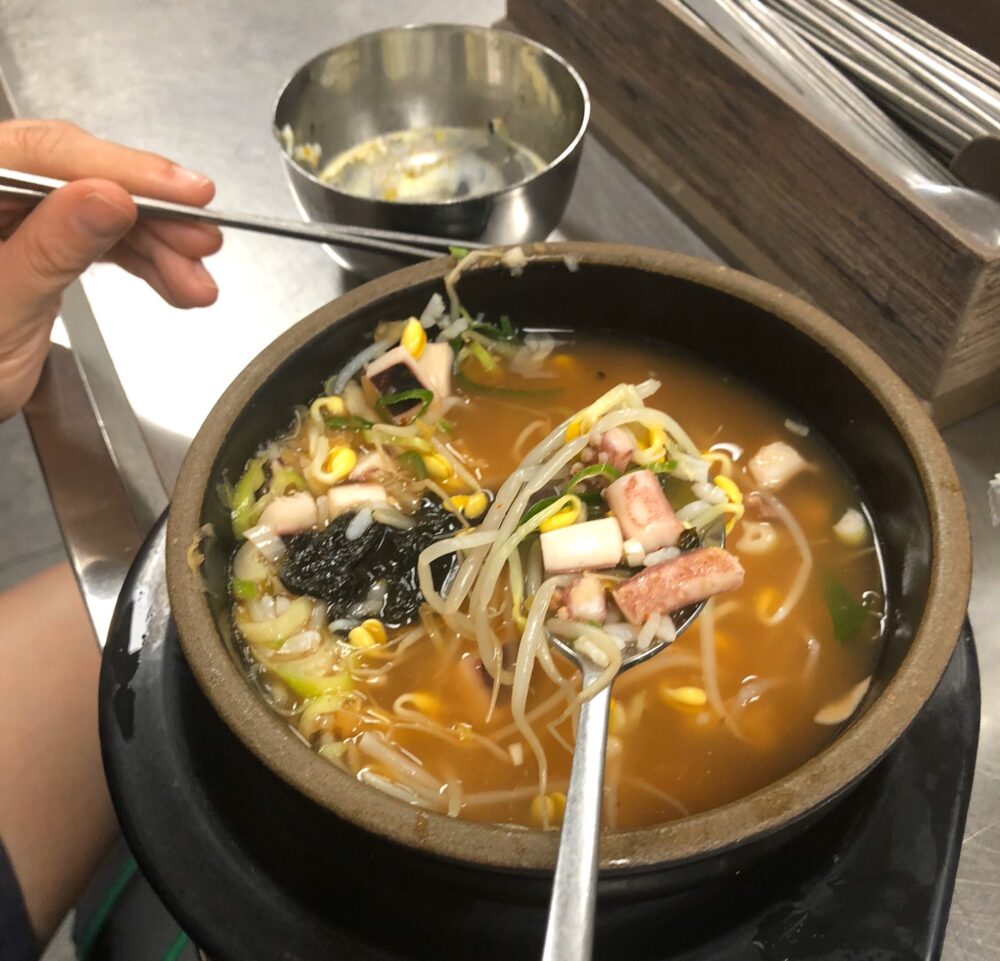
If you’re a fan of seafood, try to the squid variety.
If you’re in Jeonju on a Friday or Saturday night, head to Nambu’s Night Market! Enjoy traditional street foods, modern snacks from around the world, art and cultural performances and more.
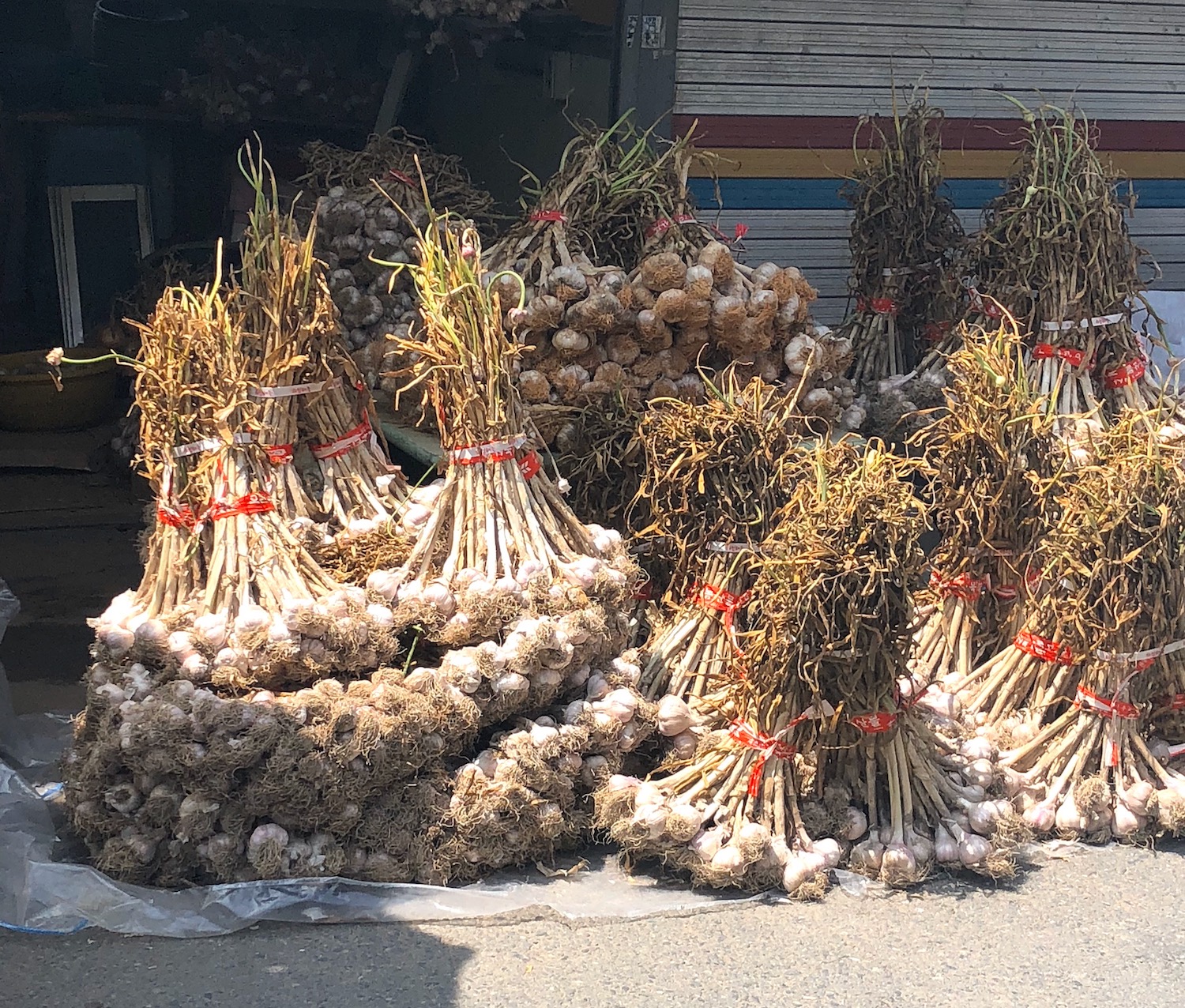
Are you a foodie traveler? Plan a visit to Chengdu, another UNESCO City of Gastronomy! For a little inspiration, check out my guide to eating your way through Chengdu!
More of our favorite meals from across South Korea!
Depending on our itinerary, you can find many of the foods shared in this post across South Korea. Here are a few more of our favorites from our 2-week adventure.
Seaweed Soup at Obok Miyeok (오복미역)
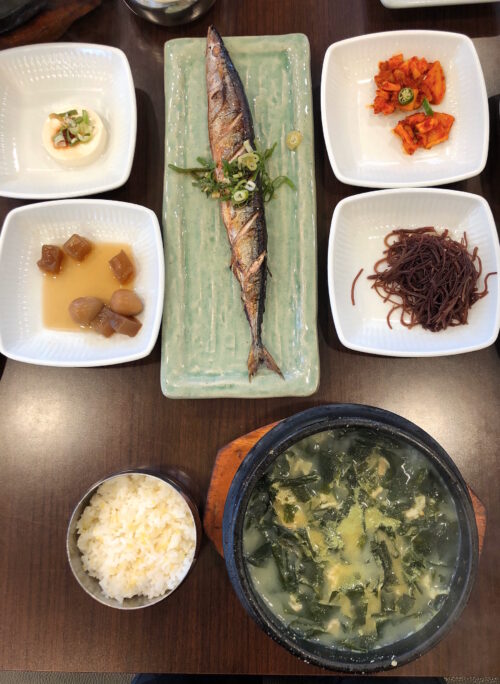
A meal at Obok Miyeok is warm and fresh. Flavorful and comforting. And, just plain beautiful. Obok Miyeok specializes in bowls of steaming seaweed soup loaded with a variety of seafood options. Choose from abalone, flounder, shellfish or even beef. The broth is slightly salty, and each bite is packed with flavor. This was the perfect meal to slow down and relax after a week of sightseeing. If you’re new to traveling in South Korea, don’t forget that your meal will come with banchan, or an array of small side dishes. The crunchy spice of kimchi and the cool, vinegary cucumbers are a perfect compliment to Obok Miyeok’s bowls of steaming soup.
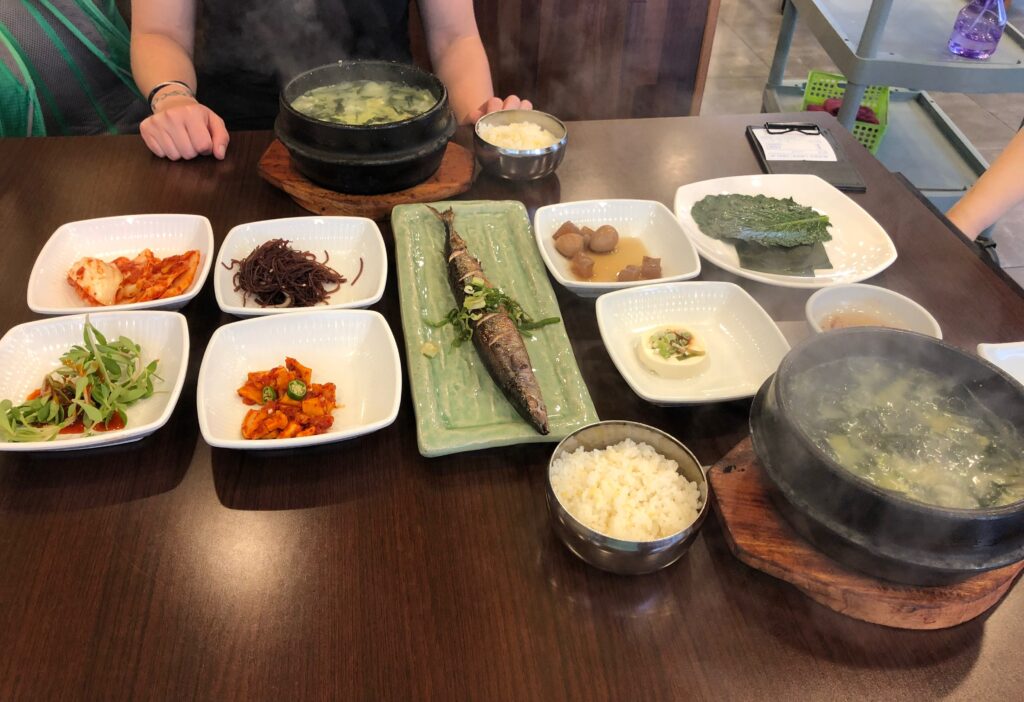
Obok Miyeok has locations throughout the country. This restaurant is a South Korean chain, but it was so good it still made my top food list.
Korean Fried Chicken
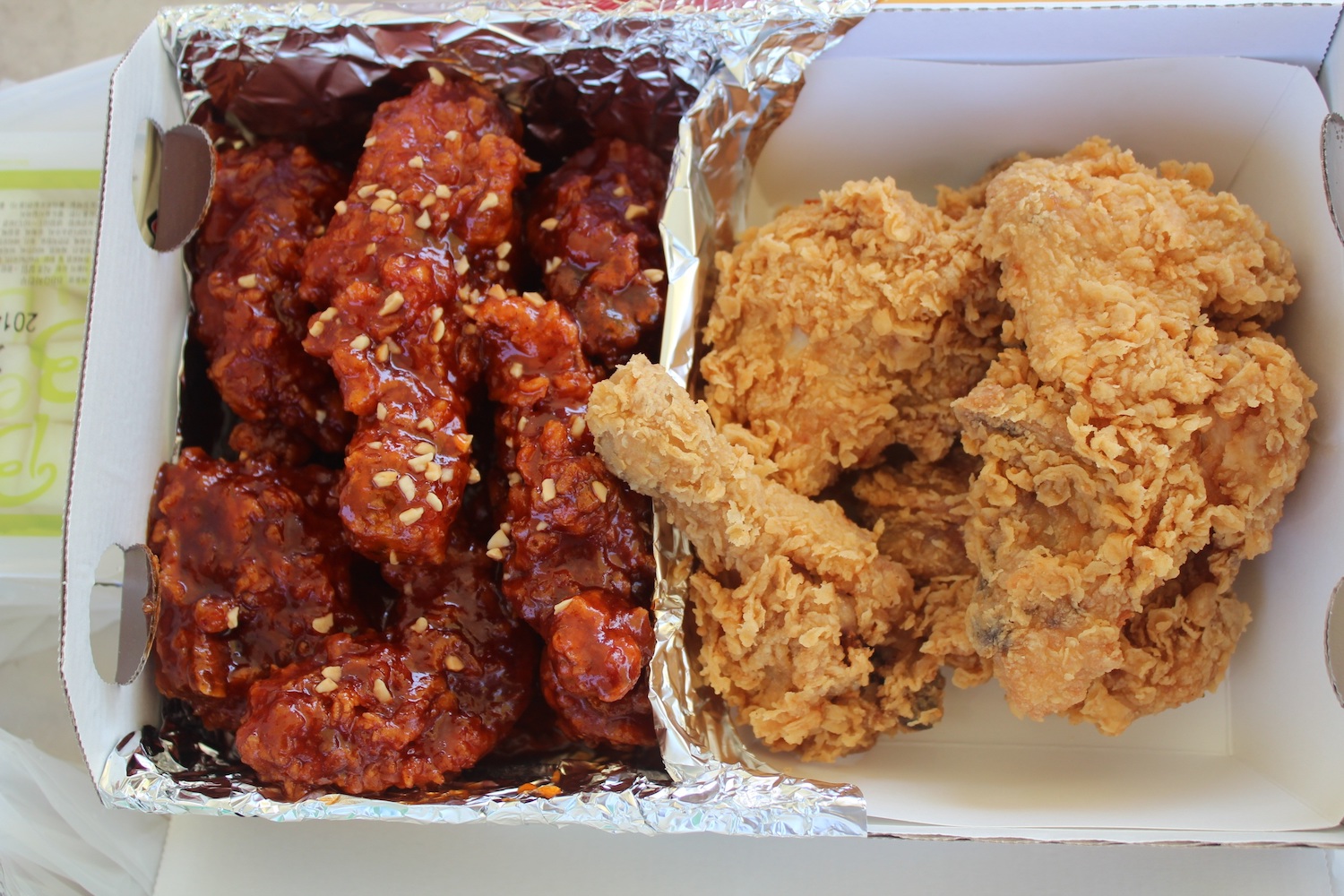
Usually fried twice, Korean Fried Chicken is the crispiest, most flavorful version of this dish that you can find! If you want to experience it like a local, have your basket of fried chicken with a side of close friends and a round of beer! Kick it up a notch, and go with Yangnyeom-chikin, (양념 치킨), chicken coated with a sweet and spicy gochujang-based sauce. Servings of fried chicken are meant to be shared! My wife & I each ordered our own basket, and there was a enough chicken to feed us for our entire 2-week trip.

Brief History of Korean Fried Chicken
Fried chicken is a very popular (and delicious!) dish in South Korea today, but its history is much more recent than many of the other dishes in this post. Fried chicken was introduced on the Korean peninsula by American troops stationed there during the Korean War. The first domestic fried chicken shop didn’t open until 1977 – Lim’s Chicken1. Over the past 50 years Korean Fried Chicken has evolved into its own dish – one that you shouldn’t miss!
1.Herald, T. (2016, May 27). History of Korean-style fried chicken. Retrieved August 23, 2020, from http://www.koreaherald.com/view.php?ud=20160527000733
Tteokbokki (떡볶이) - Soft, Spicy Rice Cakes in Gochujang
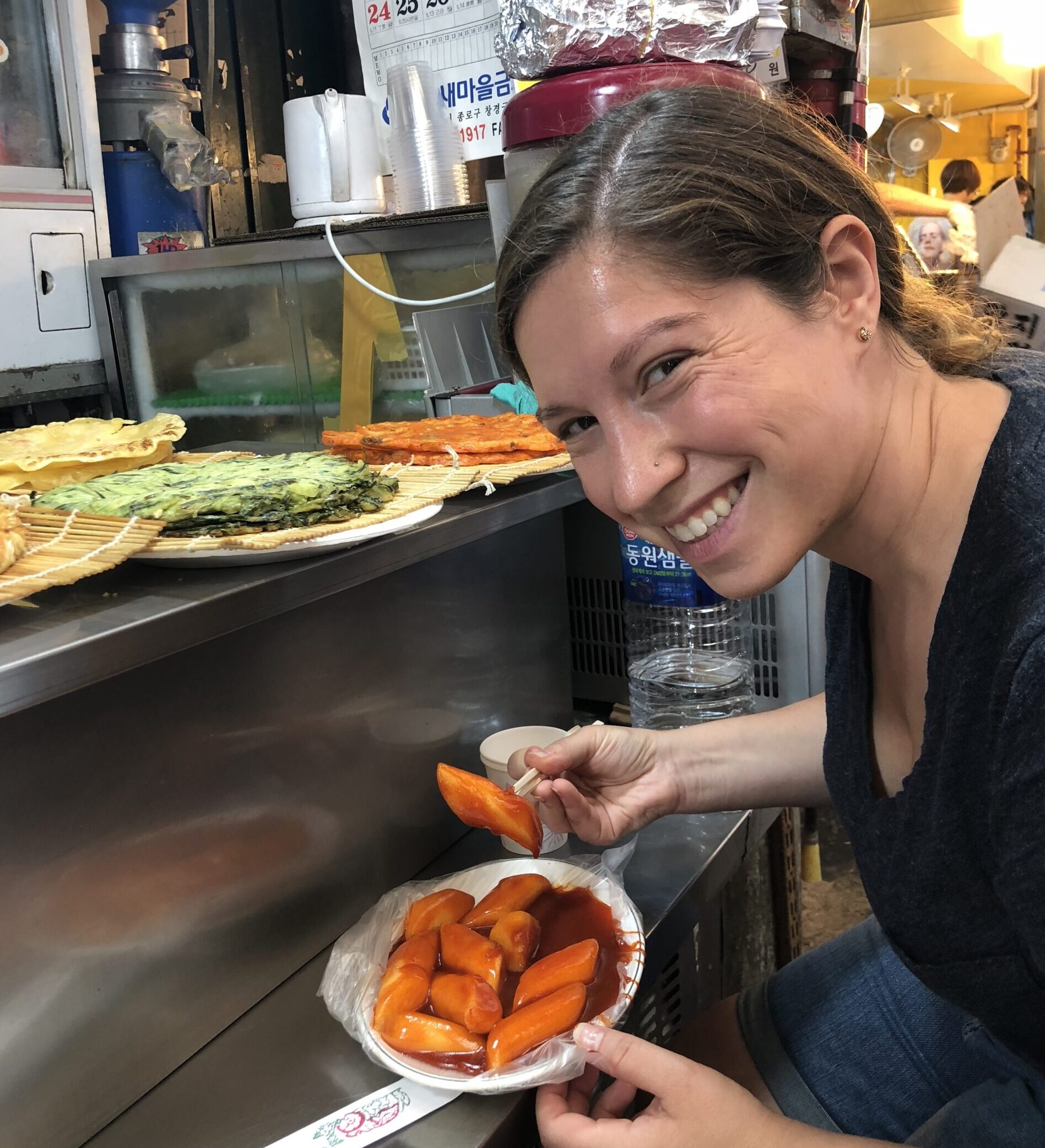
Tteokbokki was my favorite food in South Korea, and it is a must-try for anyone visiting the country. Tteokbokki is a Korean staple: soft rice cakes simmered in a saucy mixture of gochujang paste (Korean red pepper paste that is spicy, sweet and tangy all-in-one), green onions, dried anchovies, kelp and a little sugar. You’ll often find hard boiled egg as well alongside the rice cakes. Sometimes I wake up from dreaming about eating endless servings of tteokbokki. Warm, spicy delicious-ness best enjoyed while walking along the streets of South Korea.
Dookki 두끼떡볶이 - South Korea's Tteokbokki Buffet
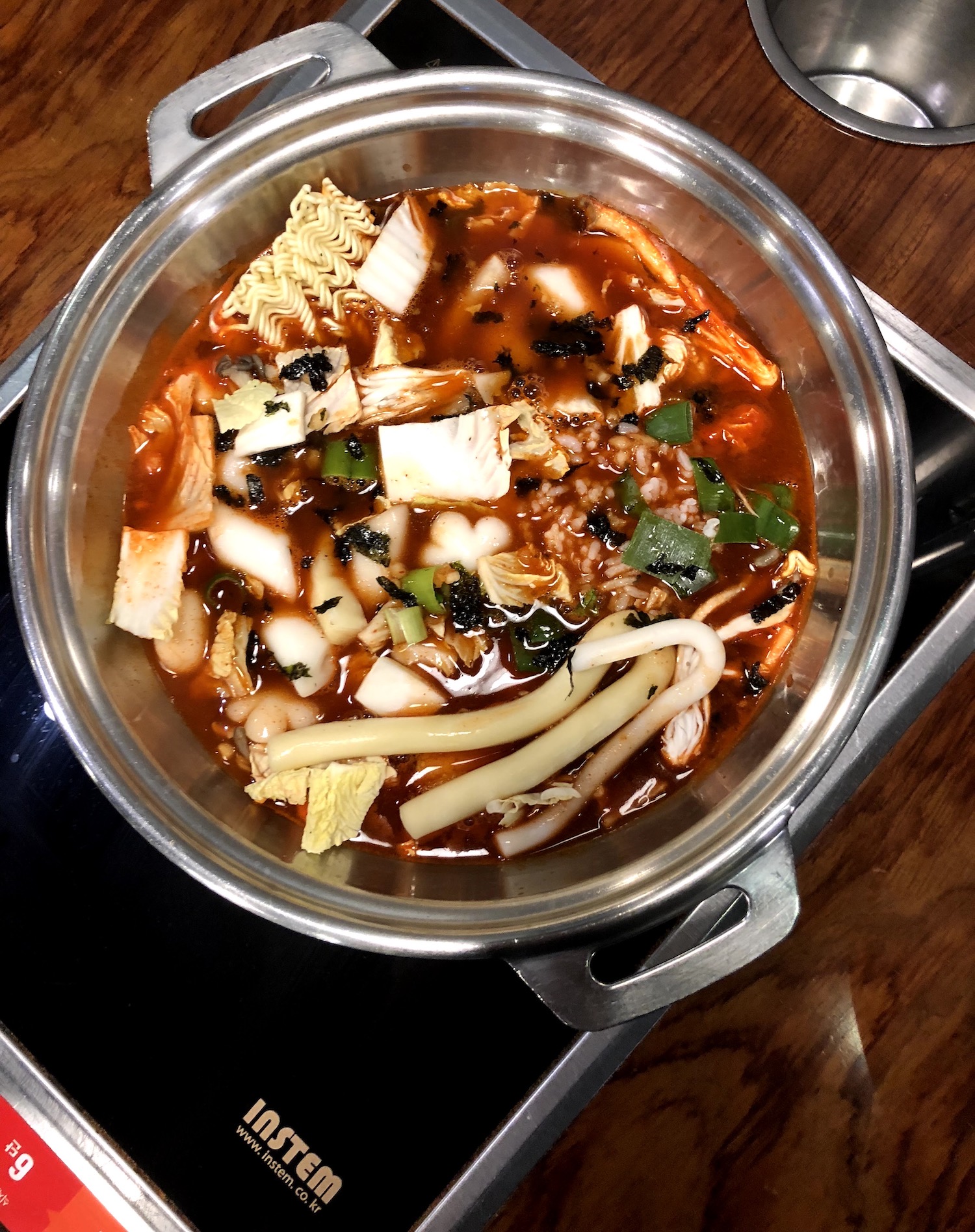
Want more tteokbokki? Check out South Korea’s tteokbokki buffet chain Dookki 두끼떡볶이! All you can eat rice cakes, fish cakes and veggies with a variety of sauces you can choose from. Each person or couple makes their own sauce right at the table in a hot-pot style. Create your own perfect spicy / sweet balance! Dookki is a franchise model, and there are locations throughout South Korea and abroad! If you search in English, you’re most likely to find the locations in Singapore or Vietnam. Search using the hanguel characters to find a Dookki location near you in Busan.
Hotteok (호떡)

Sweet, warm & fried. mmmhhmmm. Hotteok is another Korean street food you need to try! A fried wheat dough pancake filled with spices, brown sugar, peanuts and/or sesame seeds, hotteok is the perfect treat for a winter visit to South Korea. Although, I can tell you from experience that it is also a perfect treat any time of year! If you’re looking for a fun souvenir, you can buy pre-made hotteok batter mix. Try making your own version of hotteok at home.
Bungeoppang & so many more street foods to try!
There are so many other delicious street food snacks throughout South Korea just waiting for you to try! Fun, fish-shaped Bungeoppang (붕어빵) are a flour/egg/water based shell filled with a sweetened red bean paste. I probably ate about 10 of them over 2 weeks. Bungeoppang paired well with a side of Pokémon Go. (The food in South Korea was awesome, but capturing Farfetch’d was pretty great, too.)
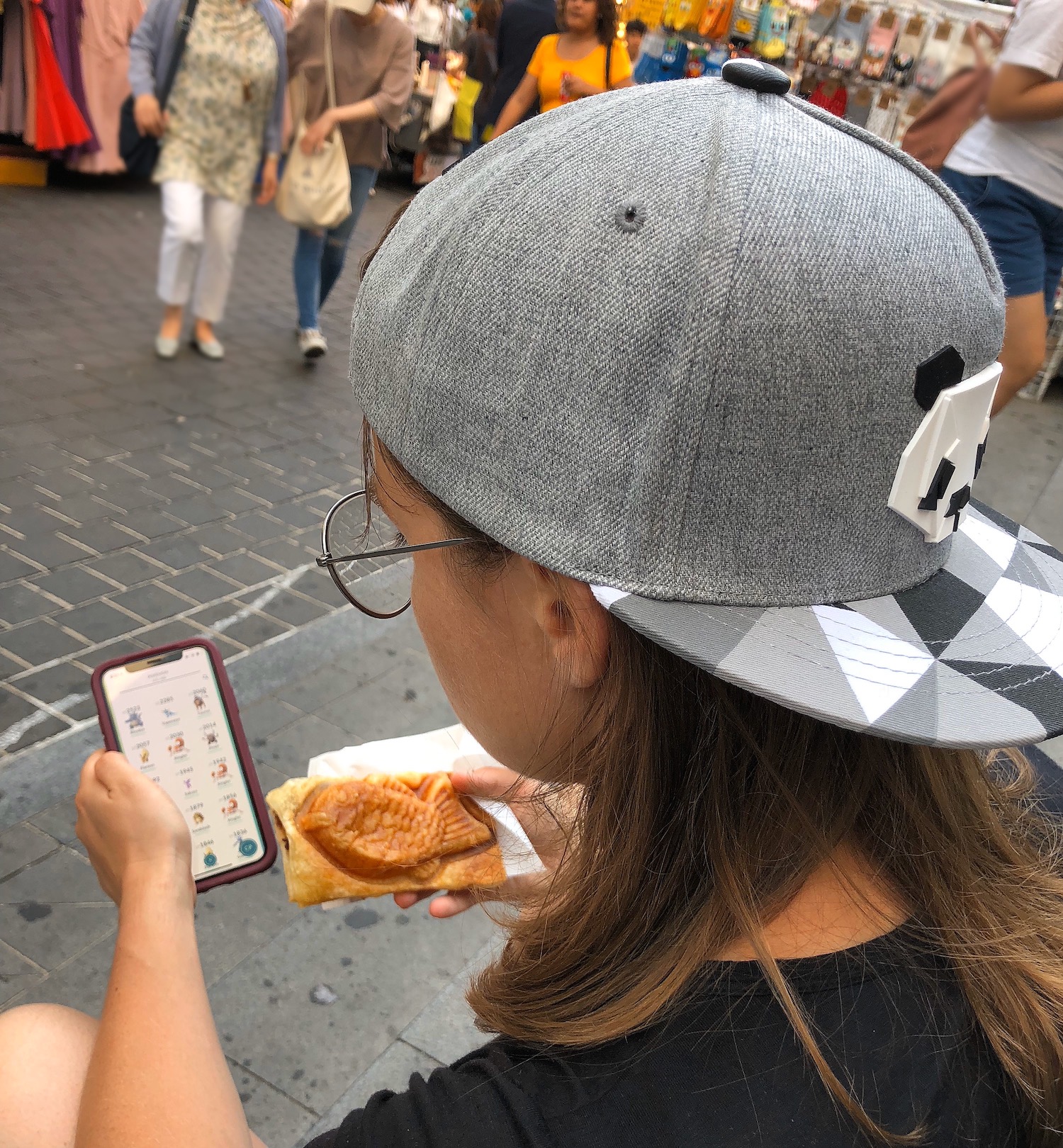
Green Tea Ice Cream
at Daehan Dawon Green Tea Plantations
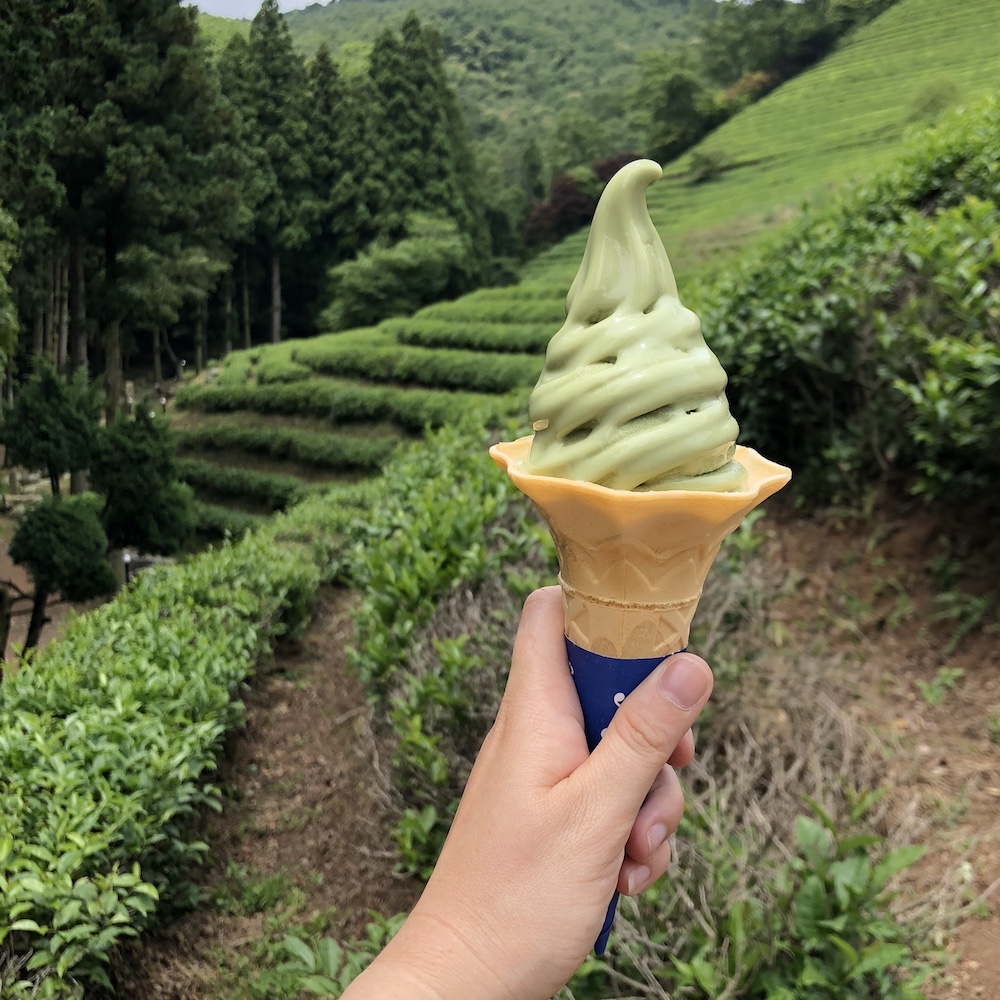
If you’re a tea drinker or a foodie, you will love visiting Daehan Dawon Green Tea Plantation in Boseong. Rolling hills covered in rows of tea, when you visit Daehan Dawon you can walk through and appreciate the plants up-close. The best part: You can enjoy a variety of green tea-infused treats while doing so! This was one of our favorite destinations in South Korea, and we didn’t hold back. We tried to the green tea noodles, matcha latte, green tea ice cream shake, and our favorite – the green tea soft serve ice cream! The ice cream was tasty, but the real novelty was learning more about the process of growing tea and the tea industry in South Korea.
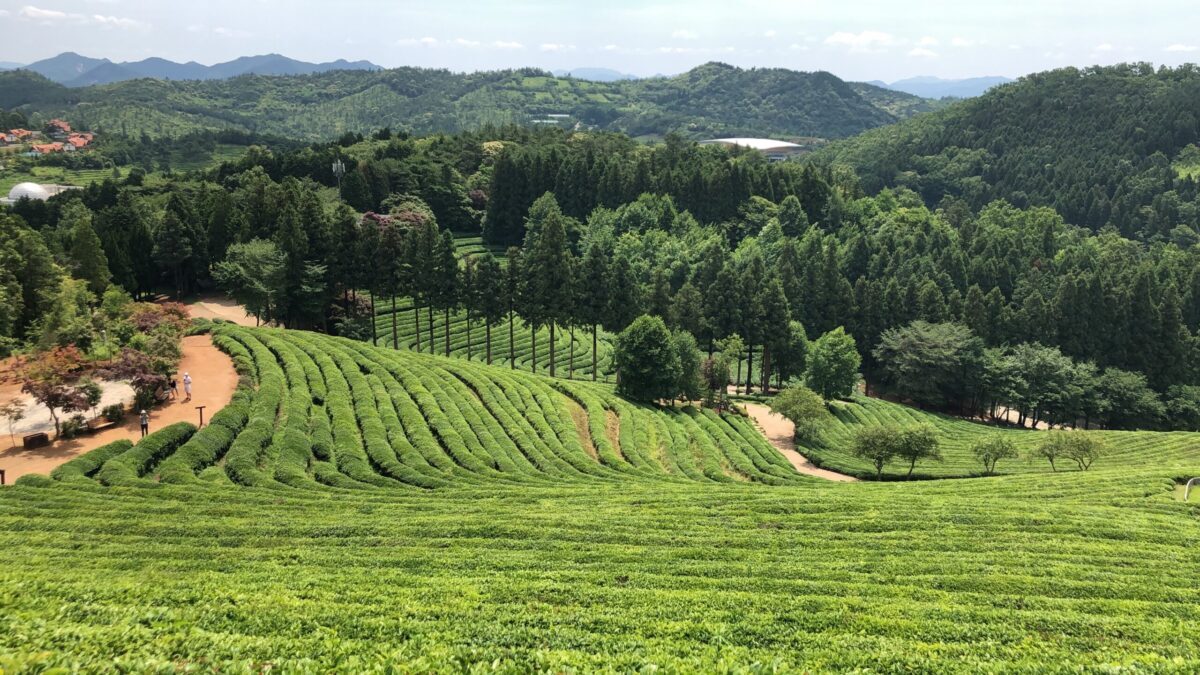
Tea Museum of Korea
Located next to Daehon Dawon Tea Plantation is the Tea Museum of Korea. Definitely build in time for a visit. Learn about the history of tea production and specifically the story behind Daehon Dawon. The museum also has exhibitions on tea cultivation and the history and cultural significance of tea and tea ceremonies.
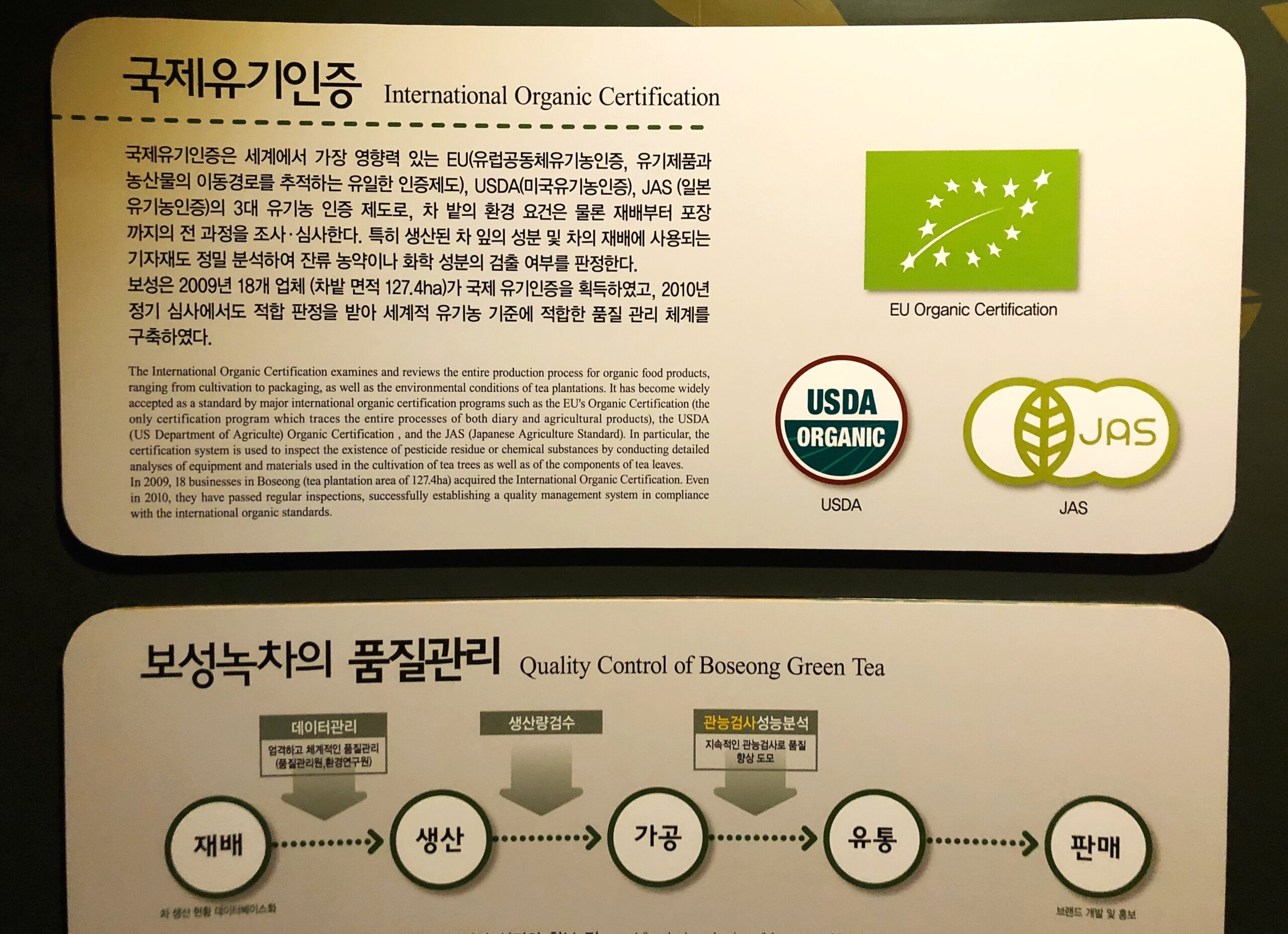
Tip: Some of the exhibits at the Tea Museum are only in Korean. I highly recommend the Google Translate app because you can take a photo of the display, and it it will translate text in the image. It isn't perfect, but it does a decent job.
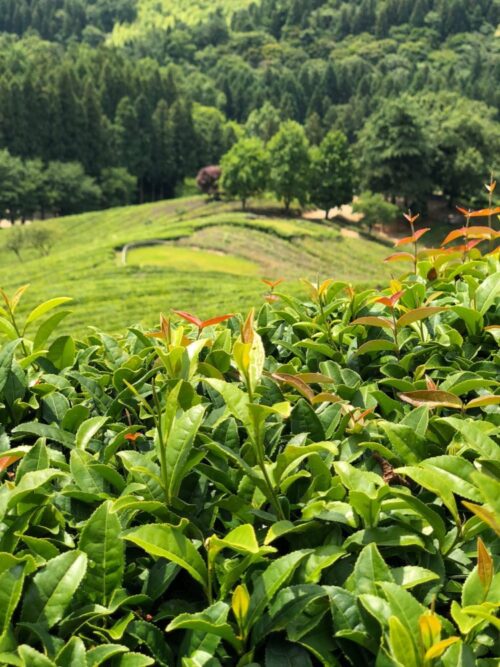
I recommend spending an overnight in Boseong. It is becoming a more popular destination for international tourists, but it is still the perfect off-the-beaten-path destination. We stayed at Nokcha Resort right next to Daehon Dawon and the Tea Museum. Since the first day was rainy we were able to settle in, visit the Tea Museum and then head to a nearby Korean spa at Yulpo Beach.
We traveled to Boseong on the public bus from Busan and then headed to Jeonju afterwards. Hiring a driver would be faster, but the bus was easy enough to navigate.
Instagrammable Desserts
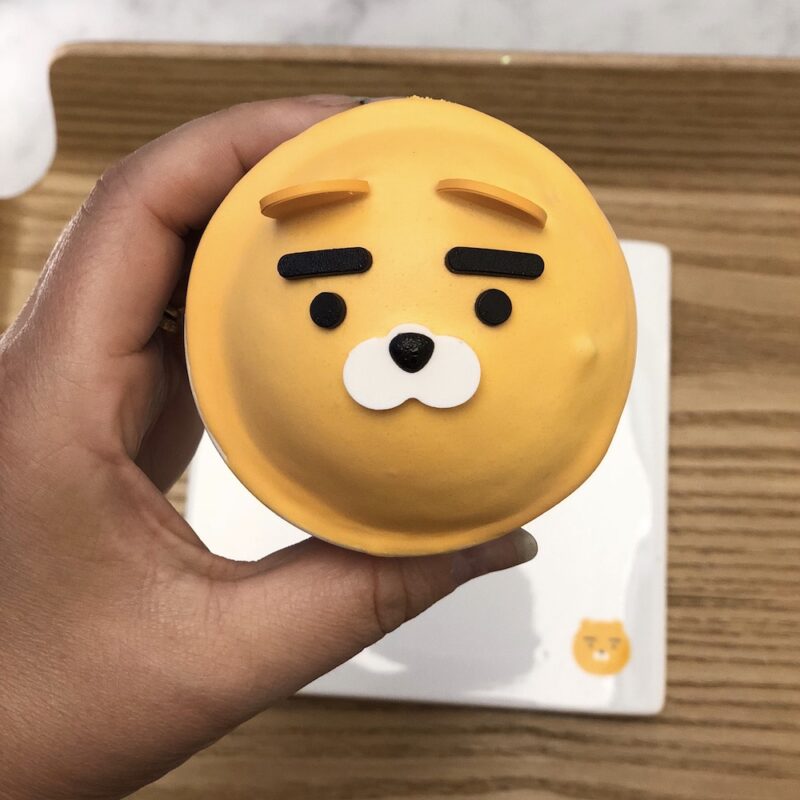
You can be assured that there are no shortage of Instagrammable dessert options throughout South Korea! From small, boutique bakeries to giant retail locations, your Instagram feed is about to get infinitely cuter. Embrace the kitsch, and you’ll have a really fun time exploring South Korea’s modern dessert scene. The flavor is not always award-winning, but they sure are cute!
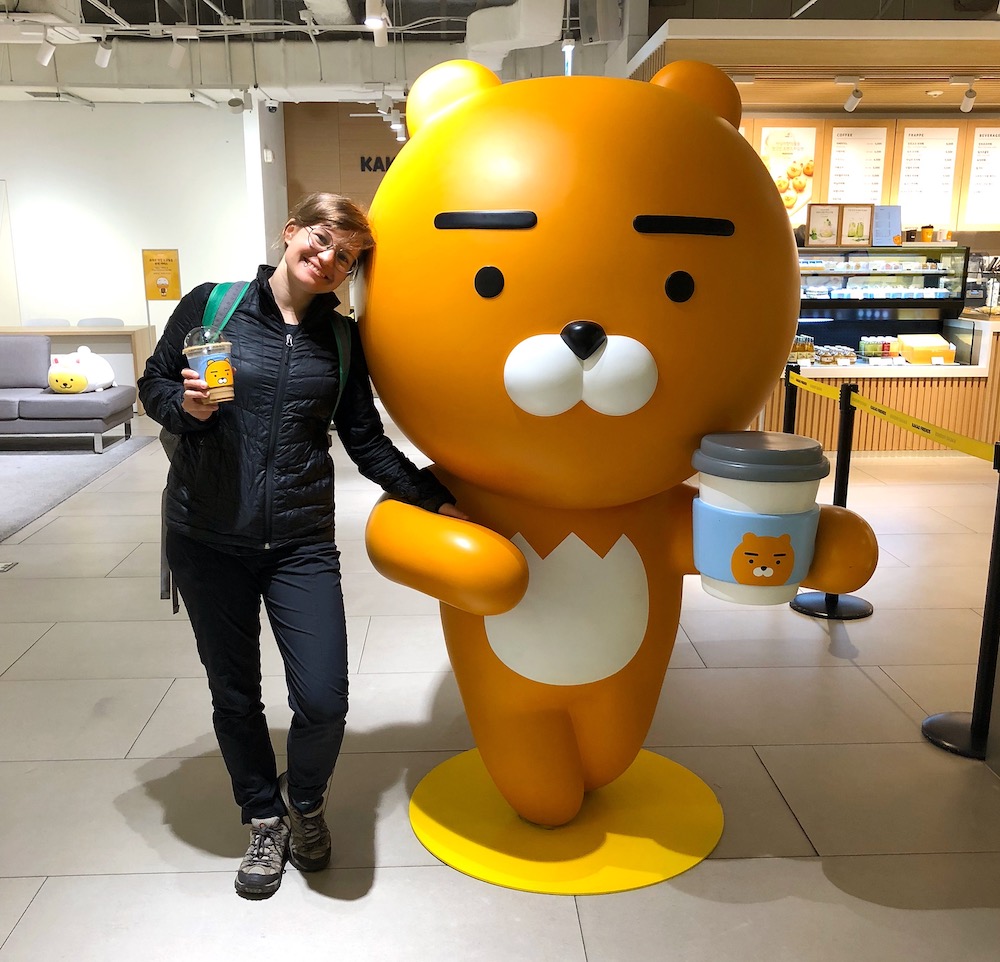
KAKAO FRIENDS Flagship Store - Ryan Cafe
KAKAO FRIENDS, originated from the Kakao Maps app, are a cartoon sensation throughout South Korea. With a cast of a couple dozen ‘friends’, at the flagship store in Seoul you can find any variety of KAKAO FRIENDS merchandise you could imagine. This even includes, cupcakes and cookies! Who can resist a cupcake that looks like Ryan, the maneless lion? If you want more character-inspired baked goods, head to the LINE FRIENDS Cafe & Store in Seoul, too.
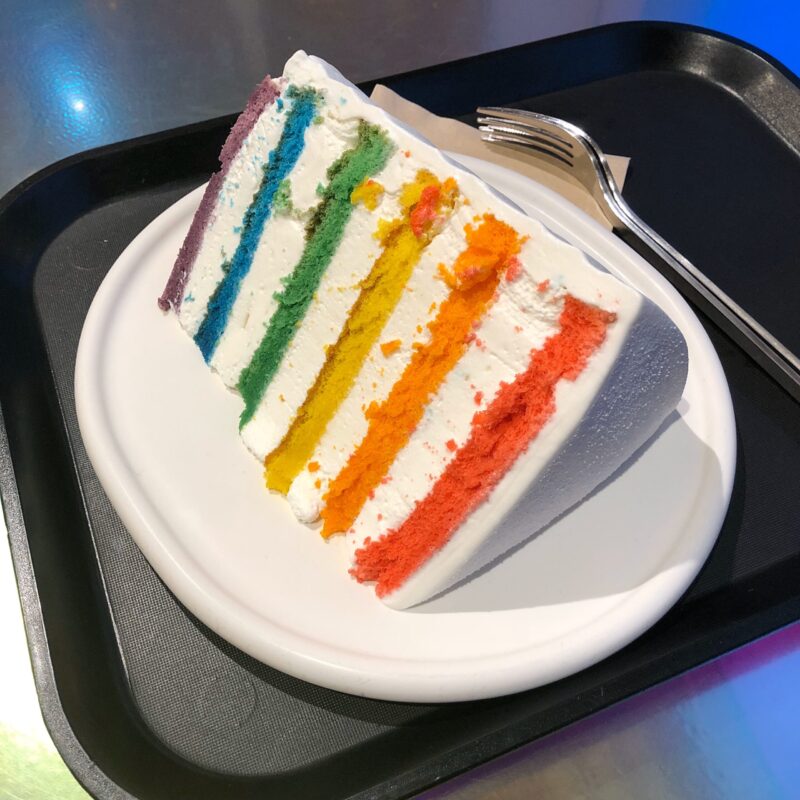
Seoul is filled with small, boutique bakeries serving desserts that are so beautifully crafted you even feel guilty eating them. Another favorite from our trip was this rainbow cake slice from DORE DORE (도레도레) in Gangnam.
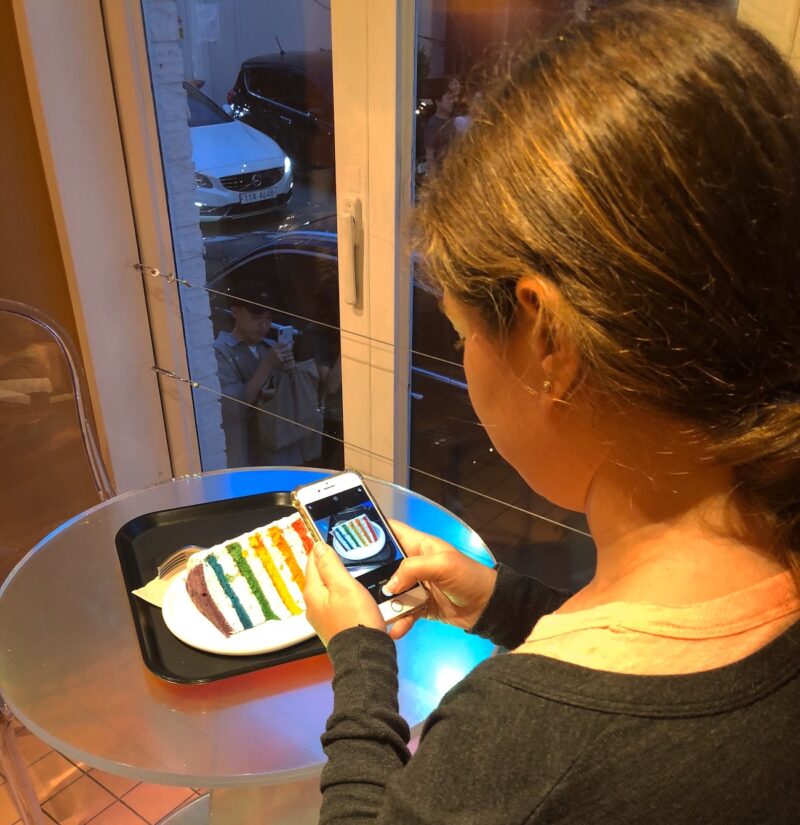
Prepackaged Snacks!
Do you share my love of exploring convenience stores and supermarkets in new countries?! Here are a few of my favorite South Korean snacks to keep your eyes out for on the next visit!
-

- Sindangdong Topokki Snack by Youus – A sweet & spicy snack mimicking tteokbokki. They aren’t quite as delicious as the real, but still a fun snack to try!
-

- Squid-flavored Peanut Balls by Orian – Roasted peanuts coated in a crunchy shell. Addictively delicious.
-

- Milkis by Lotte (Photo Credit: Hyeon-Jeong Suk, Flikr) – A milky, sweet carbonated soft drink. (Reminded me of an egg cream, minus the chocolate.) Also comes in a variety of fruity flavors.
-

- Samanco by Binggrae (Photo Credit: Mindme – Wikimedia Commons) – Fish-shaped wafer crust surrounding red bean paste and vanilla ice cream. Instead of red bean you can opt for other flavors including chocolate, strawberry & great tea. The best part of Samanco is the fun shape.
You can find all of these snacks in convenience stores and supermarkets throughout the country. There are so many fun products to try!
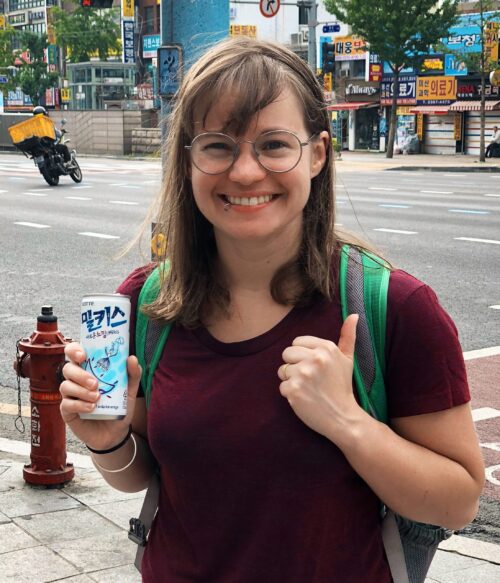
Goofy Bonus: Kimchi Fried Rice at IKEA
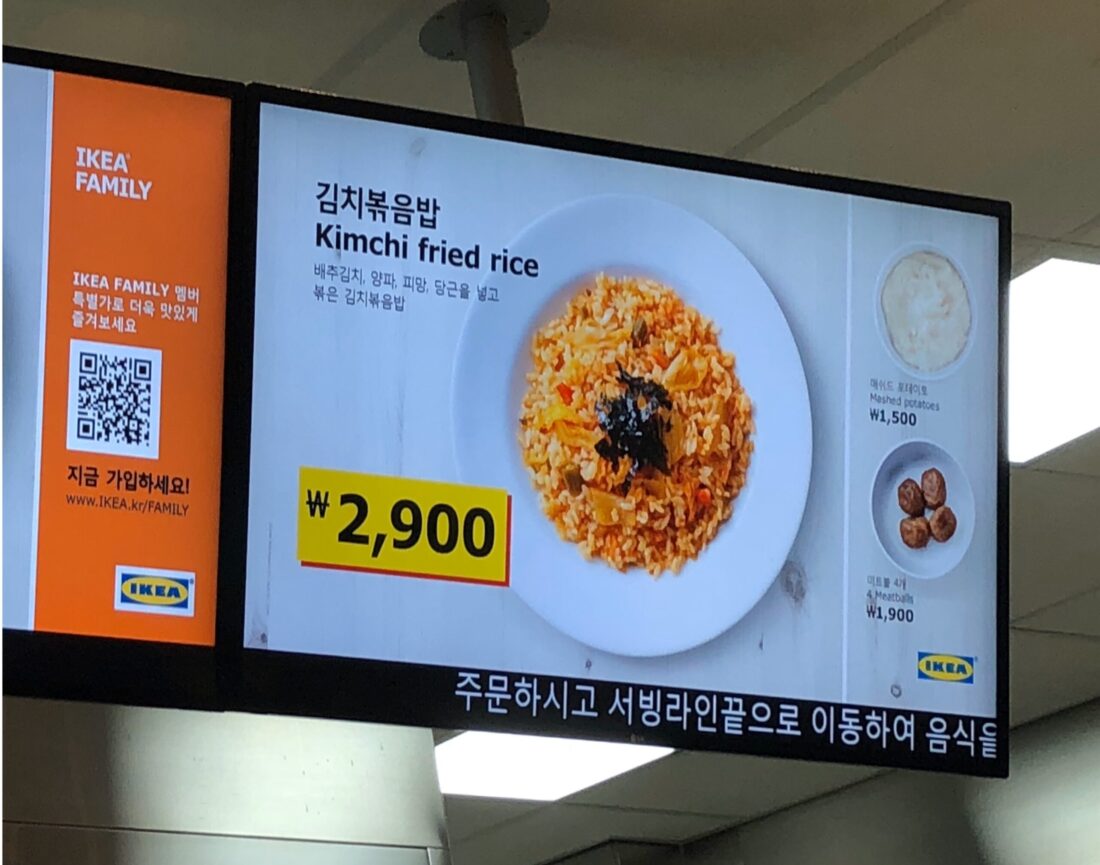
If you’re a fan of IKEA, you’ll be amused to know that meal options in South Korea include a local favorite: Kimchi Fried Rice. My wife & I headed to the outskirts of Seoul to try it out for ourselves. The kimchi fried rice isn’t winning a spot in my heart like IKEA’s Swedish meatballs, but it was a funny, memorable experience none-the-less. Also, there were some cool fake plants that we hadn’t seen before in the U.S. If you really want to cause a scene and make an enemy at the airport, put some fake plants in your carry-on luggage… ::face palm::.
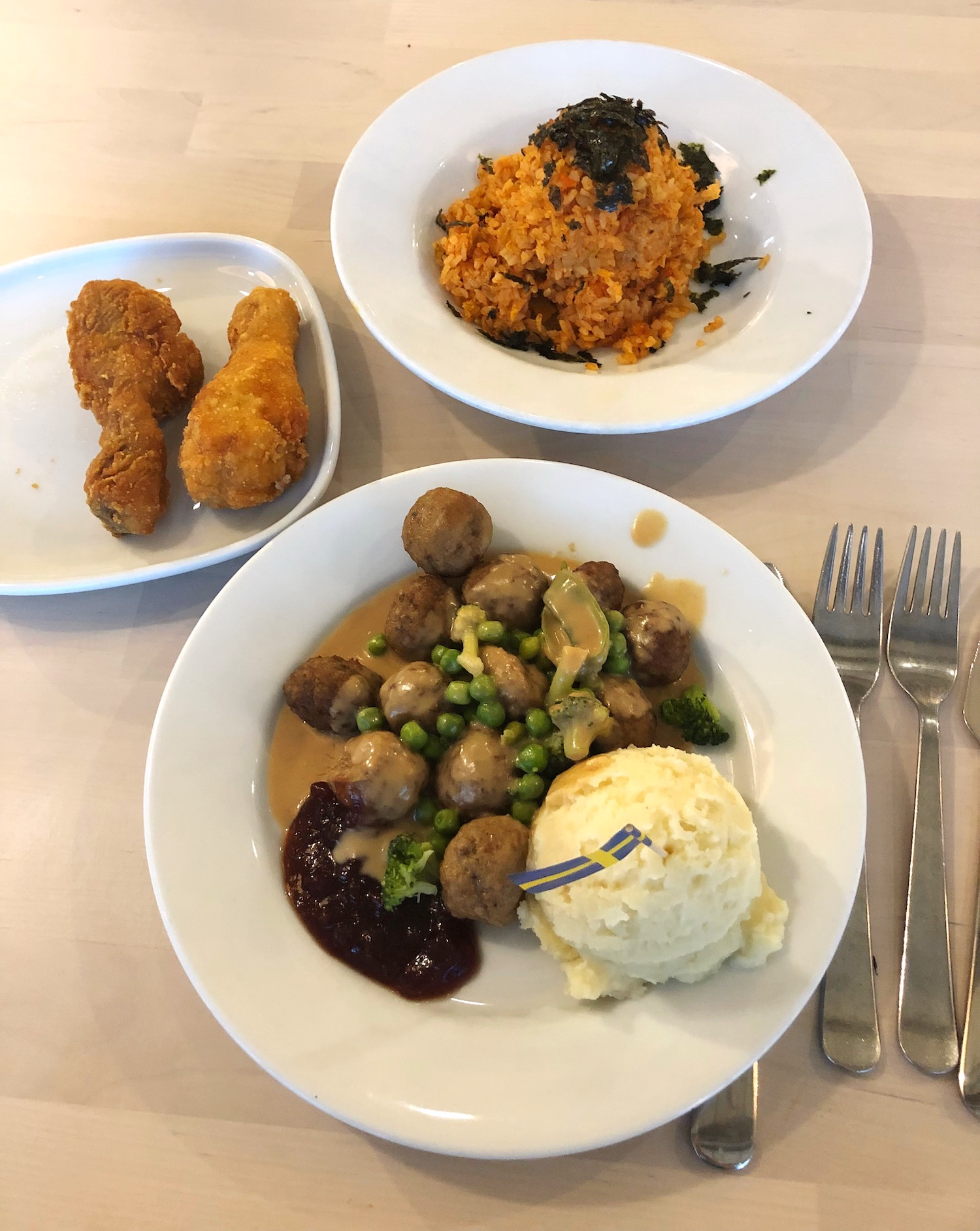
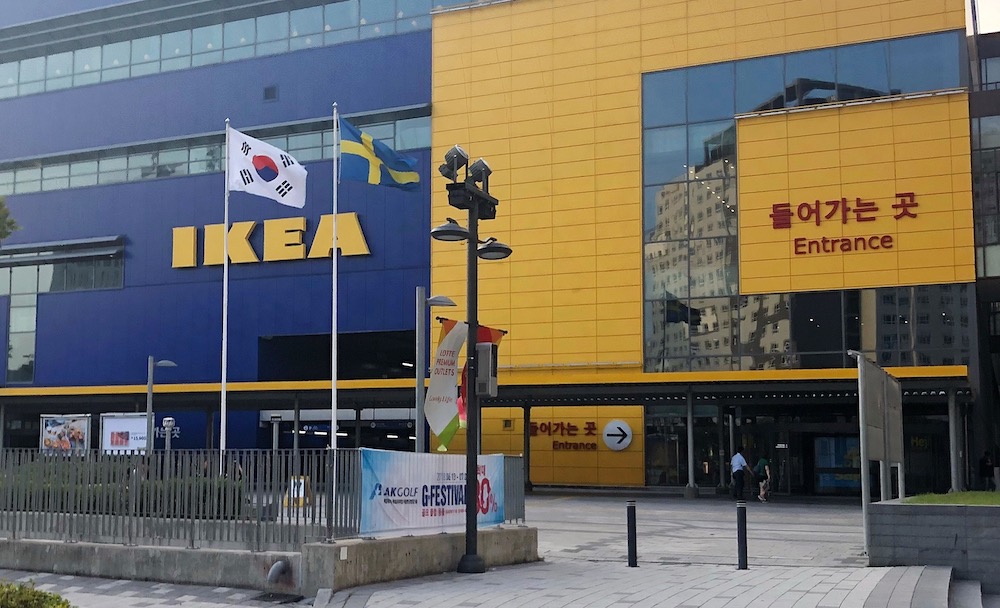
Thank you for joining for this foodie adventure through the best meals in South Korea! Reach out for any advice or additional recommendations as you plan your upcoming visit. Or, if you have other must-try recommendations for food to try when in South Korea, let us know in the comments!
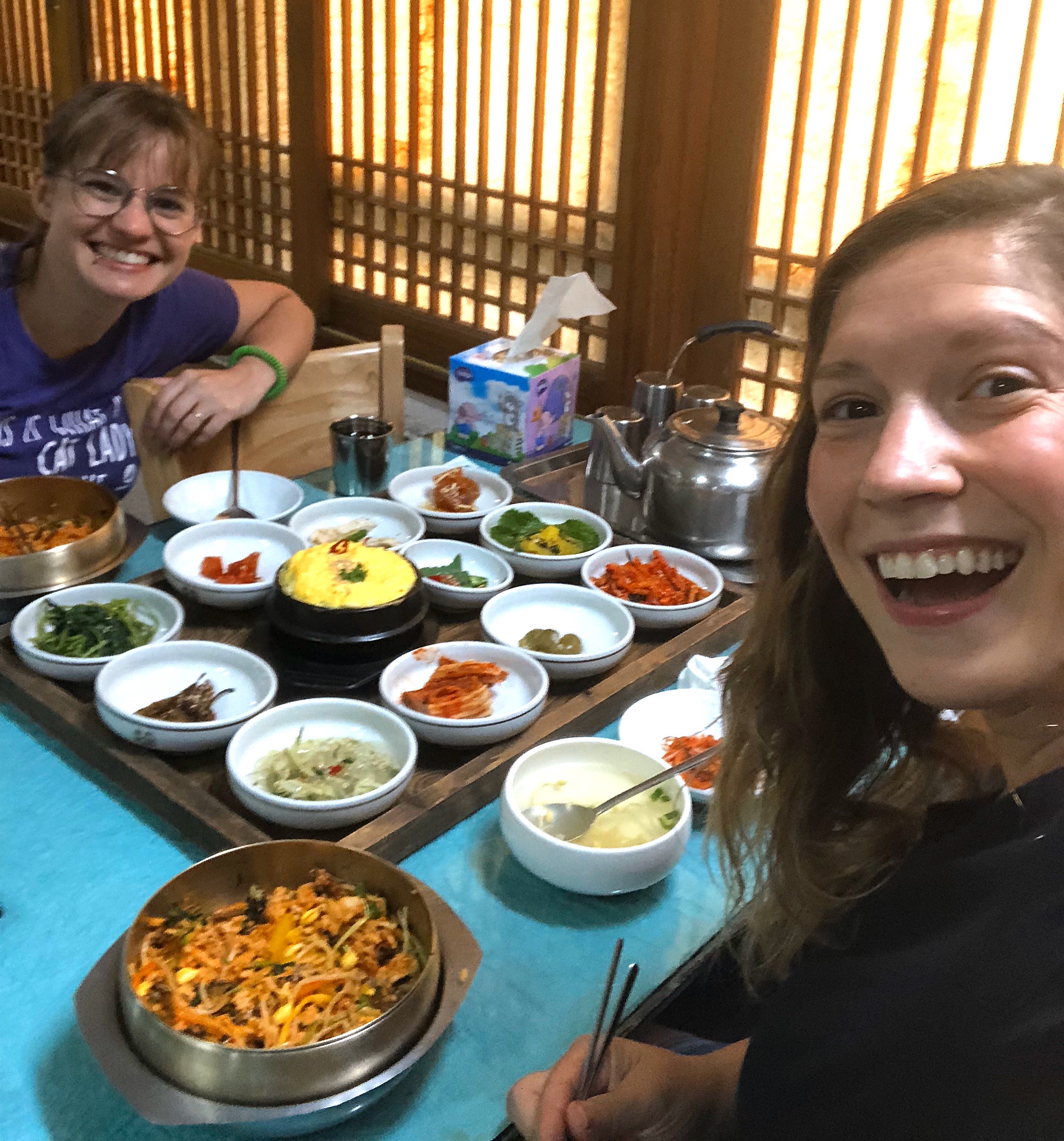

Like it? Pin it!



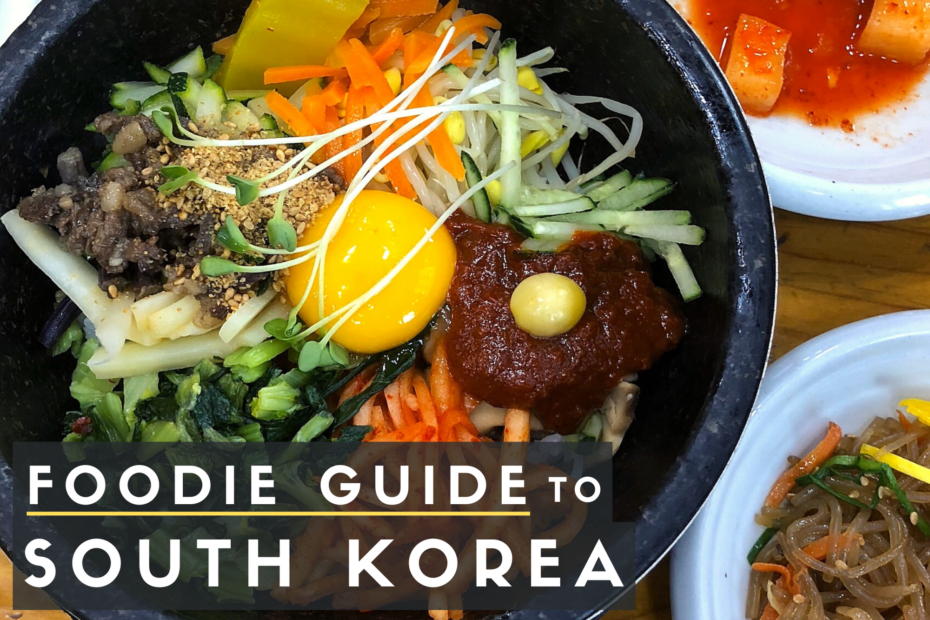
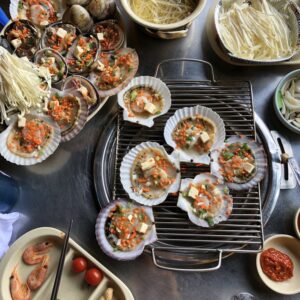
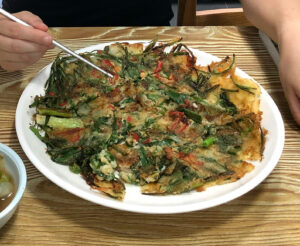
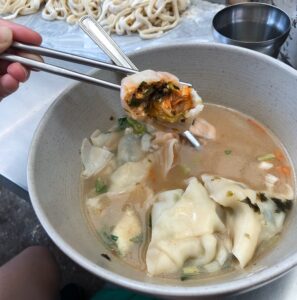
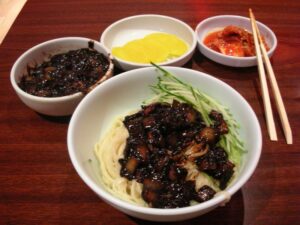
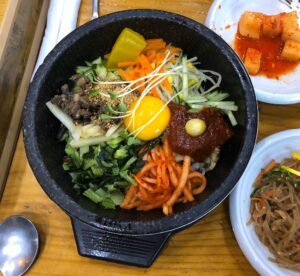
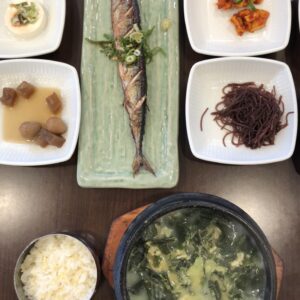
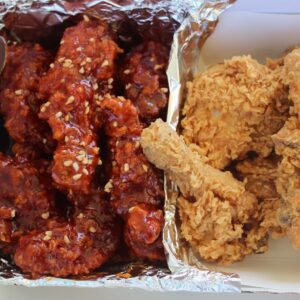
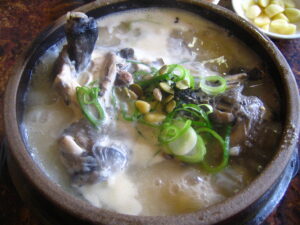

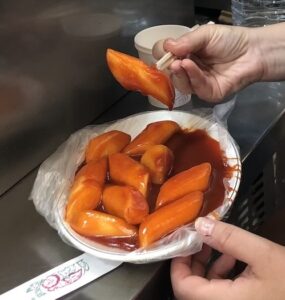
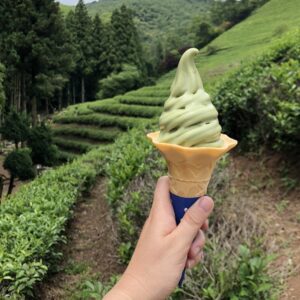
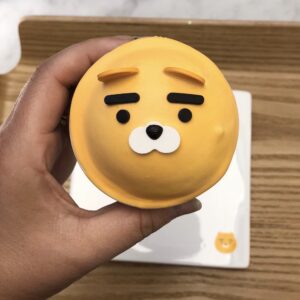
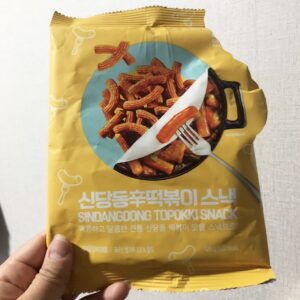
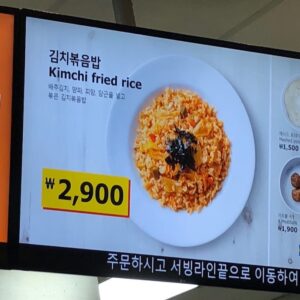

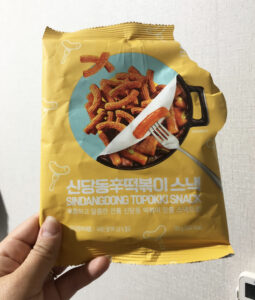
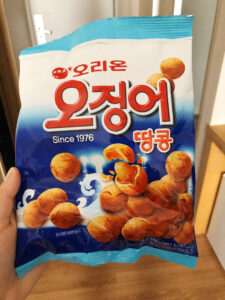
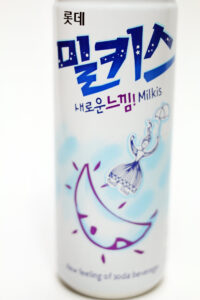
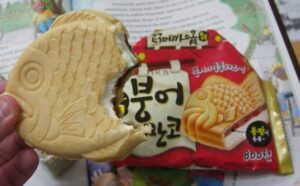
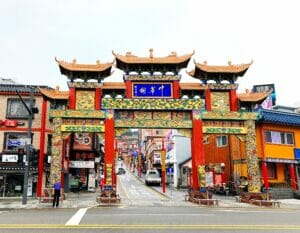
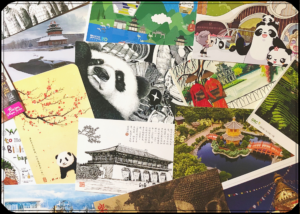

wow this post is amazing! I love Korean food but have never actually been to Korea, now I want to visit even more to try all these foods I didn’t even know about!!
This food guide has left me so hungry! Everything looks so fresh and delicious – thanks for the tasty inspiration!
So cool to see all those Korean dishes! As a foodie I always love to try local cuisine. From your list I have only tried bibimbap and I adore it! Thanks for all the suggestions!
I’ve never been to Korea but I think I would love all the “instagrammable” food spots! This is such a thorough post, and smart to include the Korean characters in case a traveler has your post up and wants to just point 😀
Omg this post made me miss my time in Korea so bad! I’ve tried all of these and now I’m really craving these unique flavours. My favourite meal will probably always be Bulgogi soup.
Oh wow! This post!! I love Korean food but I’ve never been to South Korea. Your photos have just pushed it up my wishlist straight to the top. Drooling!
Pingback: Winning Carbonations - 14 Must-Try, Unique Sparkling Drinks